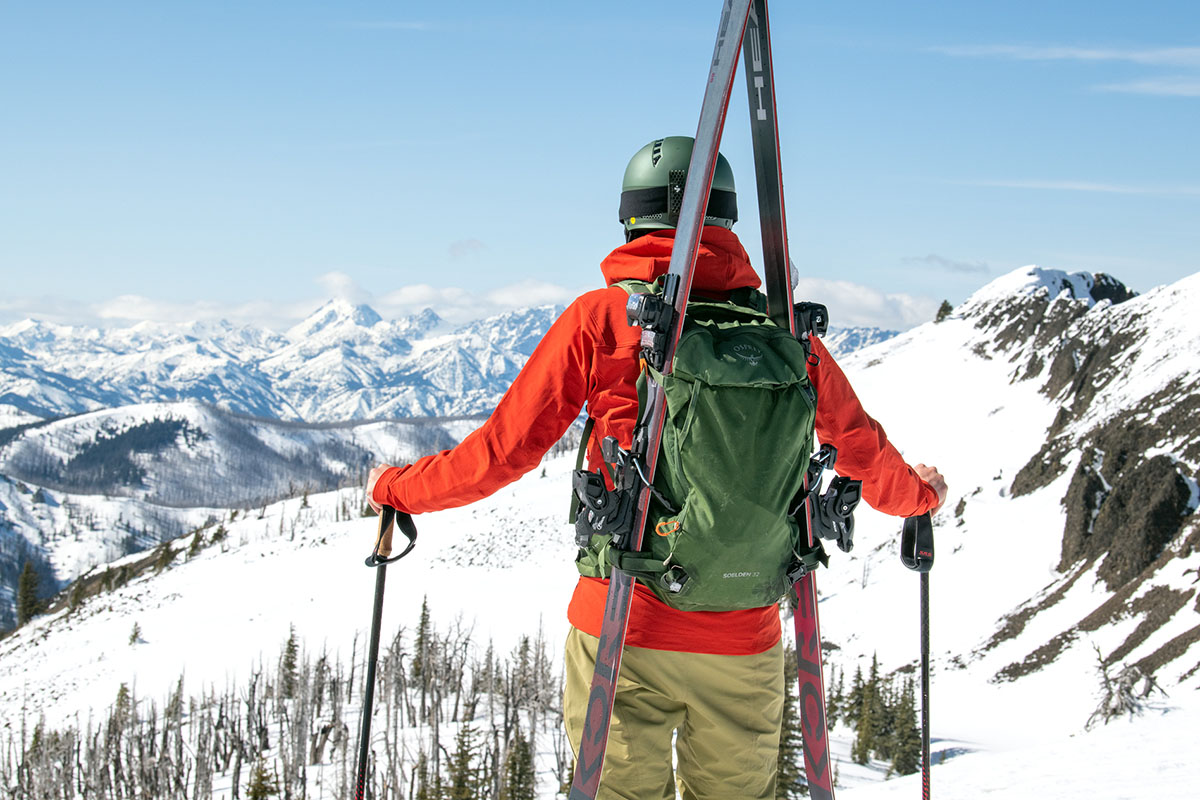
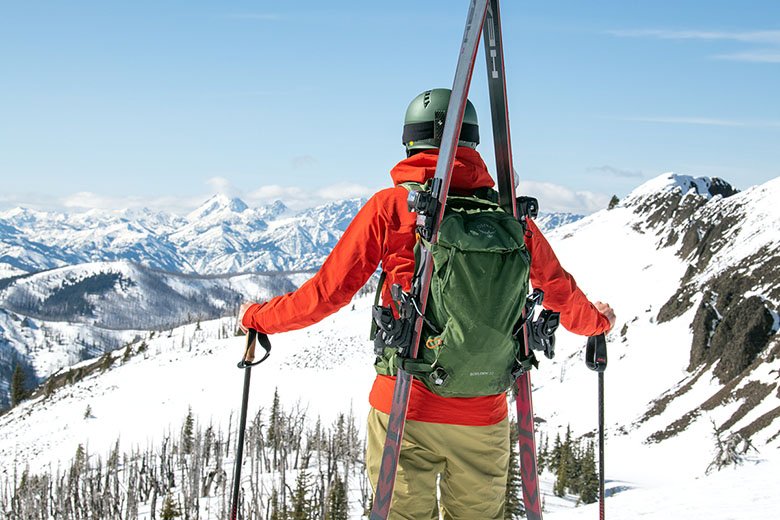
Switchback Travel (Jason Hummel)
Whether you’re headed to the resort or gearing up for a big backcountry outing, a pack is useful for carrying your essentials: extra layers, water, snacks, and—if you’re going out of bounds—avalanche equipment. Unique design features that set ski backpacks apart include dedicated pockets for goggles and avy gear, multiple access points, and external ski or snowboard carry straps. It’s also becoming more common to find deployable airbags built in for use in the event of a slide. Below are our top ski backpacks for the 2024 season, including options for day touring and resort skiing, ski mountaineering missions, and those equipped with airbags. For more information, see our ski backpack comparison table and buying advice below the picks.
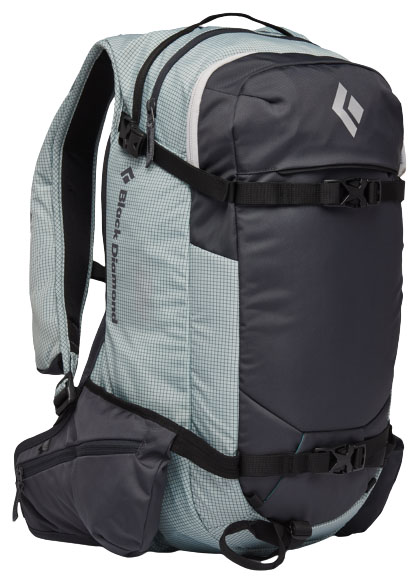 Category: Day touring
Category: Day touring
Capacities: 15, 25, 32L
Weight: 2 lb. 9 oz.
What we like: A refined feature set that leaves nothing lacking.
What we don’t: Black Diamond packs aren’t always top-notch quality (although we’ve been impressed by their ski lineup).
Black Diamond has become a big player in backcountry ski gear, and the Dawn Patrol 32 is their jack-of-all-trades touring pack. Freshly updated for last season, it boasts all the bells and whistles we look for in well-featured design, including zippered backpanel access, external helmet and ice tool attachments, extra-large hipbelt pockets, and a dedicated avy tool compartment. You also get an insulated shoulder pocket for electronics or hydration—a nice detail that few ski-specific packs include and crucial for cold-weather reservoir use—and metal hipbelt buckle that’s far more durable than most plastic designs. The net result is great versatility for all types of ski missions, from transition-heavy tours to schlepping big loads into the mountains.
The Black Diamond holds its own in other metrics too: Comfort-wise, we appreciate the extra padding on the backpanel, which isolates your body from the inevitable bulges of ski gear inside. Materials are decently durable, too (including burly 840D nylon reinforcements), and the Dawn Patrol has straps for both ski and snowboard carry. We’ll admit that we’ve found Black Diamond packs to be hit or miss in terms of durability, but their ski lineup stands out with thoughtful designs and great build quality (we also include their Cirque and JetForce packs below). The Dawn Patrol also comes in a resort-ready 15L and versatile 25L, but the 32L here is the best capacity for most day tours, whether you’re hitting yo-yo laps in the sidecountry or venturing deeper into the mountains.
See the Black Diamond Dawn Patrol 32
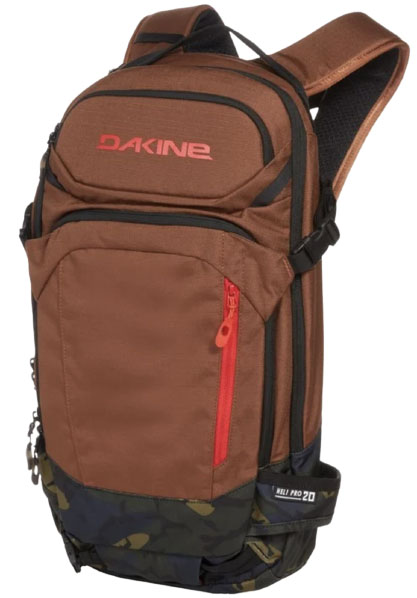 Category: Resort/day touring
Category: Resort/day touring
Capacities: 20, 24L
Weight: 1 lb. 14.3 oz.
What we like: Streamlined and affordable design for inbounds and sidecountry use.
What we don’t: No backpanel access; snow safety pocket is a tight squeeze for most shovels.
For resort skiers, aspiring backcountry enthusiasts, and those on a budget, the Dakine Heli Pro checks all the boxes for an in-bounds/day-touring pack in an affordable $100 package. Similar to the Dawn Patrol above, the Heli Pro features a dedicated snow safety gear pocket and hydration sleeve, and tacks on a fleece-lined goggle pocket (the Dawn Patrol has a compartment for smaller items, but the fleece is a nice touch). Made with snowboarders in mind, the Heli Pro offers vertical and horizontal board carry, in addition to diagonal and A-frame ski carry options.
What do you sacrifice by going cheaper? For starters, you lose the convenience of backpanel access to the main compartment, which—for touring—is one of our most-loved (and most-used) ski pack features. Additionally, the Heli Pro’s avy-tool pocket is a tight fit for most shovels, and the 20-liter capacity will be too minimal for most human-powered backcountry adventures. And finally, Dakine’s build quality simply doesn’t measure up to that of dedicated backpack brands like Osprey, Deuter, and Gregory. But the Heli Pro gets the job done for resort riding and forays into the slackcountry, and packs in an extra dose of style, too.
See the Dakine Heli Pro 20L See the Women's Dakine Heli Pro 20L
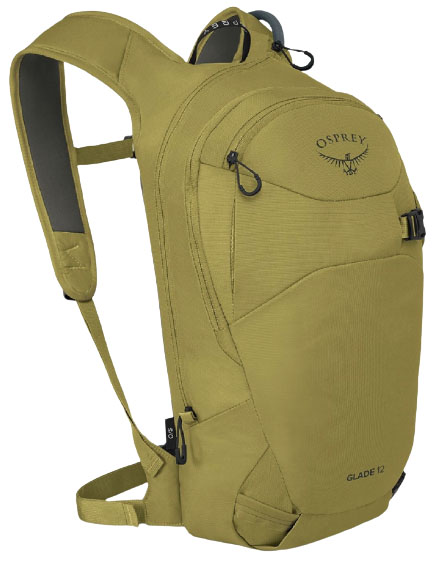 Category: Resort
Category: Resort
Capacities: 5, 12L
Weight: 2 lb. 0.4 oz.
What we like: All you need for the resort and nothing that you don’t.
What we don’t: ‘Tweener capacity lacks versatility.
Not everyone will wear a backpack at the resort, but it can be a nice solution if you like to stay hydrated or pack your own lunch. Osprey’s Glade 12 is our favorite pick in this category for a few key reasons. First, the pack comes with a quality 2.5-liter Hydrapak hydration reservoir that features an insulated hose, which is essential for keeping water from turning into ice. The low-profile shape and minimal straps make the pack unobtrusive on the chairlift, and tuck-away attachments deploy to secure your ski or snowboard for the occasional bootpack to access sidecountry terrain. And importantly, the Glade is versatile for all types of winter sports—from skiing to snowmobiling and snowshoeing—with features like a goggle pocket and glove-friendly zippers and buckles.
Many of the packs here could pull double duty for resort skiing or riding, but 30 liters (or more) is overkill unless you’re carrying skins, a helmet, and extra layers, too. In the end, those frequenting lift-access terrain will benefit from a more streamlined design like the Glade 12. On the other hand, if you’re just wanting to bring along some extra water, the 5-liter Glade might be a better bet and will save you $30. Regardless of the capacity, it’s hard to beat Osprey’s top-notch carrying comfort and fit, which ensures that the pack won’t get in the way while you’re bombing downhill. If you already have a hydration reservoir (and don’t want to pay for another), check out Gregory’s Verte 12 below, which features a similar design and retails for $110.
See the Osprey Glade 12 Hydration Pack
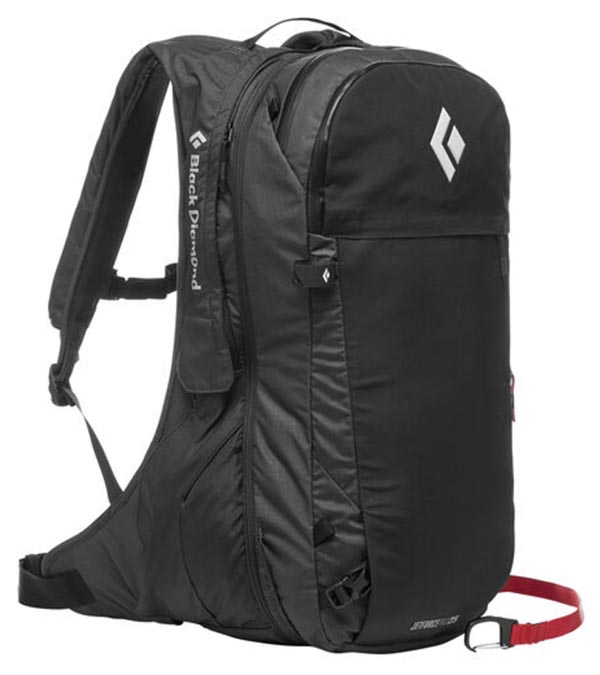 Category: Airbag
Category: Airbag
Capacities: 10, 25, 35L
Weight: 6 lb. 8 oz.
What we like: The most cutting-edge electric airbag available; modular design allows for multiple capacities.
What we don’t: Expensive and not as simple as a canister-powered system.
There are ski backpacks, and then there are airbag-equipped ski backpacks. In short, an airbag is deployed in the event of a slide and helps you stay on the surface of the snow as it moves down the mountain. While certainly not a substitute for proper education, good judgement, and avalanche rescue gear (including a beacon, shovel, and probe), there’s growing evidence that airbags have a notable impact on survival rates. For the 2024 season, Black Diamond’s top-of-the-line JetForce Pro is our favorite all-around design, featuring a proprietary battery-powered airbag that’s exceptionally lightweight and easy to recharge. Further, with its modular system (“boosters” can be purchased separately in 10, 25, and 35L sizes, as well as a 25L splitboard version), you can get just-right carrying capacity no matter if you’re skiing the sidecountry or on a multi-day tour.
Compared to canister airbags, an electric airbag is more convenient and doesn’t require you to refill your canister each time you pull the trigger (great for practice deployment). The fan also continues to spin once the airbag is deployed, keeping it inflated even if punctured by a rock or tree, and it’s suitable for air travel (compressed air/gas canisters are not permitted on airplanes). And with added Bluetooth capability, the Pro allows you to run diagnostic tests, update software, and customize settings, which is quite simply next level. But the JetForce Pro is not without competition, namely from supercapacitor-powered systems like the BCA Float E2-25 below (which is both more affordable and lighter weight). You can learn more in our dedicated avalanche airbag pack round-up, but for now the JetForce Pro is our recommendation for the most premium and time-tested system of the season... Read in-depth review
See the Black Diamond JetForce Pro 25L
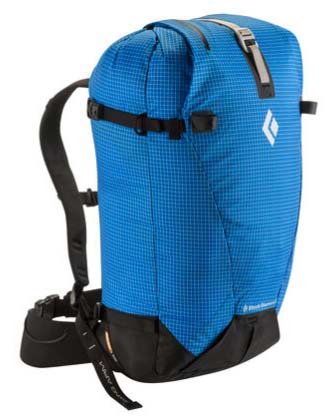 Category: Ski mountaineering
Category: Ski mountaineering
Capacities: 30, 35, 45L
Weight: 2 lb. 4 oz.
What we like: A streamlined pack that sports all the necessary features for big missions.
What we don’t: Doesn’t carry heavy loads well; no snowboard carry.
Ski mountaineering objectives often require big-mileage days and an assortment of technical gear. For that, you’ll need a pack that can carry everything you need without weighing you down, and the Black Diamond Cirque fits the bill nicely. The Cirque includes all the necessary trimmings for technical missions including two easily deployable ice-axe loops, diagonal or A-frame ski-carry straps, a helmet flap, and a rope strap under the top lid. It also features an internal sleeve for rescue gear that’s separated from the main compartment by a flap, saving weight and giving the exterior a sleek and streamlined look. At only 2 pounds 4 ounces for the 45-liter version, you get a generous amount of space for the weight, making the Cirque a great choice for fast-and-light missions.
The Cirque has earned its place as our top pick for ski mountaineering objectives, but it does have room for improvement. For starters, although the largest version can accommodate 45 liters of gear, the lack of load lifters and stiff suspension means it isn’t quite as comfortable as we’d like. Further, because the top load strap doubles as the diagonal ski carry strap, we’ve found it difficult to max out the capacity while carrying our skis diagonally—and if you carry your skis in an A-frame configuration, you cut off access to the side zipper. That said, we've found the side zipper to be almost too short to be useful, making the Cirque primarily a top-loading pack (Patagonia's Descensionist below features a much more functional side zip). We love the Cirque’s low weight and streamlined build, but those looking for more features or a plusher suspension will be better served by packs like the Deuter Freerider Pro or Gregory Targhee below.
See the Black Diamond Cirque 45
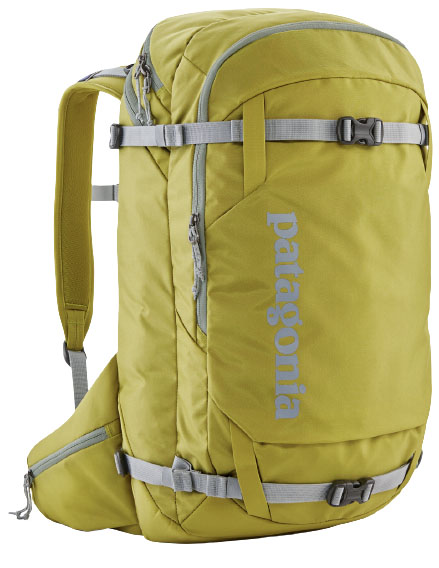 Category: Day touring
Category: Day touring
Capacity: 20, 30L
Weight: 2 lb. 10 oz.
What we like: Very convenient organization for day tours.
What we don’t: Doesn’t fare well when overloaded; no women's-specific version.
There’s no shortage of ski packs to choose from, but for backcountry riders who prioritize convenient organization and a high-end fit and finish, Patagonia’s SnowDrifter 30L is a real standout. This is one of the most user-friendly designs we’ve tested with full-zip backpanel access to the main compartment, a dedicated goggle/accessory pocket that doesn’t get pinched down when the pack is full, and generously sized hipbelt pockets. You also get an avy tool compartment with helpful sleeves for separating safety gear, a wide U-shaped zipper at the top for secondary main compartment access, and external helmet carry. Importantly, the pack also holds its shape well when empty, which is a nice bonus for staying organized during transitions.
The SnowDrifter goes head to head with our top-ranked Black Diamond Dawn Patrol, but we give the edge to the Dawn Patrol for a few reasons. First and foremost, the Patagonia lacks the insulated hydration sleeve, oversized hipbelt pockets, and durable metal waist buckle of the Black Diamond—all features that we love and part of what makes the Dawn Patrol such a functional pack. Second, the SnowDrifter is only available in two capacities (the Dawn Patrol is offered in three), and stock issues are common. But for over $20 less, the Patagonia features a more durable build (420D throughout vs. the BD's 210D with 840D reinforcements), which could be enough to tip the scales for some. For top-notch organization and convenience for casual day tours, the SnowDrifter 30L is a great alternative to have on your radar.
See the Patagonia SnowDrifter 30L
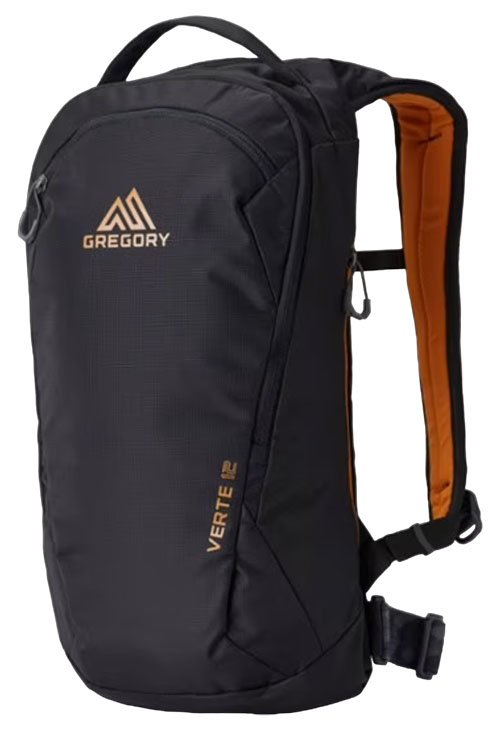 Category: Resort
Category: Resort
Capacities: 12, 18L
Weight: 1 lb. 6.7 oz.
What we like: Wide, elasticized hipbelt offers a great fit and uninhibited movement, with no webbing tails.
What we don’t: Does not include a hydration reservoir with purchase.
The Osprey Glade above is a great resort pack for those who want the all-in-one convenience of an included hydration reservoir, but there’s also a lot to like about the Gregory Verte. The Verte retains many of the same features as the Glade—including a 12-liter capacity, clean and streamlined design with minimal straps, snow-shedding backpanel, and ski and snowboard attachments—but tacks on a few noteworthy elements. We especially love the side zippered pocket that offers ideal access while sitting on a chairlift, along with the wide, elasticized hipbelt that adjusts via a slider (similar to a goggles strap). Not only does this hipbelt offer a nice fit and great freedom of movement, but it also eliminates the webbing tails normally found on one-size-fits-all packs (including the Osprey Glade).
If you already have a hydration reservoir on your hands, we think the Verte is the pack to get. The features mentioned above offer a boost in fit and finish compared to the Glade, particularly the supportive and streamlined hipbelt. And thanks to the Verte’s insulated hydration sleeve, you can use your summer reservoir all year—no need for an insulated tube (plus, the ability to zip away your hydration tube means you have one less thing to think about when bombing down the slopes). For a boost in capacity, Gregory also offers an 18-liter version of the pack, which can handle a day’s worth of supplies for assisted side and backcountry skiing, along with more ski and snowboard carry options.
See the Gregory Verte 12
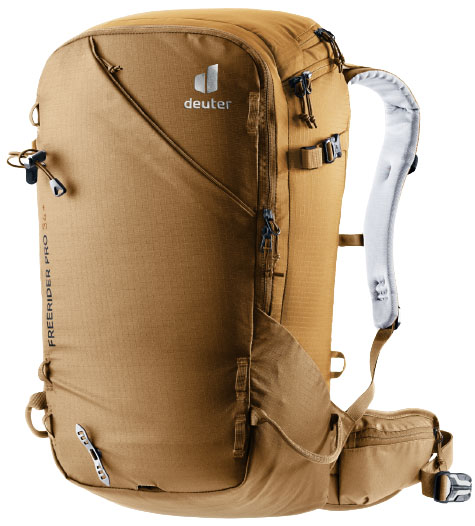 Category: Ski mountaineering/day touring
Category: Ski mountaineering/day touring
Capacity: 34 + 10L
Weight: 2 lb. 13 oz.
What we like: A well-integrated roll-top expands to fit 10L of extra space.
What we don’t: A few minor design flaws.
Germany-based Deuter is best known for their hiking and backpacking designs, but their Freerider series of ski packs shouldn’t be overlooked. The Pro 34+ in particular stands out for its all-around nature, and it received a noteworthy update this season that gives it 10 liters of expandable capacity via a roll-top closure. We’ve found this redesign to be very well-integrated (it doesn’t get in the way when you don’t need it), and the added versatility is significant: the Freerider Pro stays compact and streamlined for casual day tours yet is still able to accommodate a rope, harness, and hardware for more technical missions.
After testing the Freerider Pro all winter, we have just a few minor nitpicks: The front pocket is a bit of a squeeze for a pair of skins (especially a bulky nylon model), and you have to unbuckle the shoulder straps to fully unzip the backpanel, which is an extra step compared to other designs here. And while it’s true that the Pro 34+ is a bit heavy for a lightweight ski mountaineering pack, the extra ounces could be worth it for the expandable design and Deuter’s reliable comfort and fit. What’s more, for $30 less than the Black Diamond Cirque above you get more durable fabrics, significantly more organization (including backpanel access and a fleece-lined goggle pocket), and the choice between men’s and women’s sizes. The Pro 34+ is a bit hard to track down at the time of publishing, but Deuter also makes a more streamlined 30L version that retains most of the same features but forgoes the expandable design.
See the Deuter Freerider Pro 34+ See the Deuter Freerider Pro 32+ SL
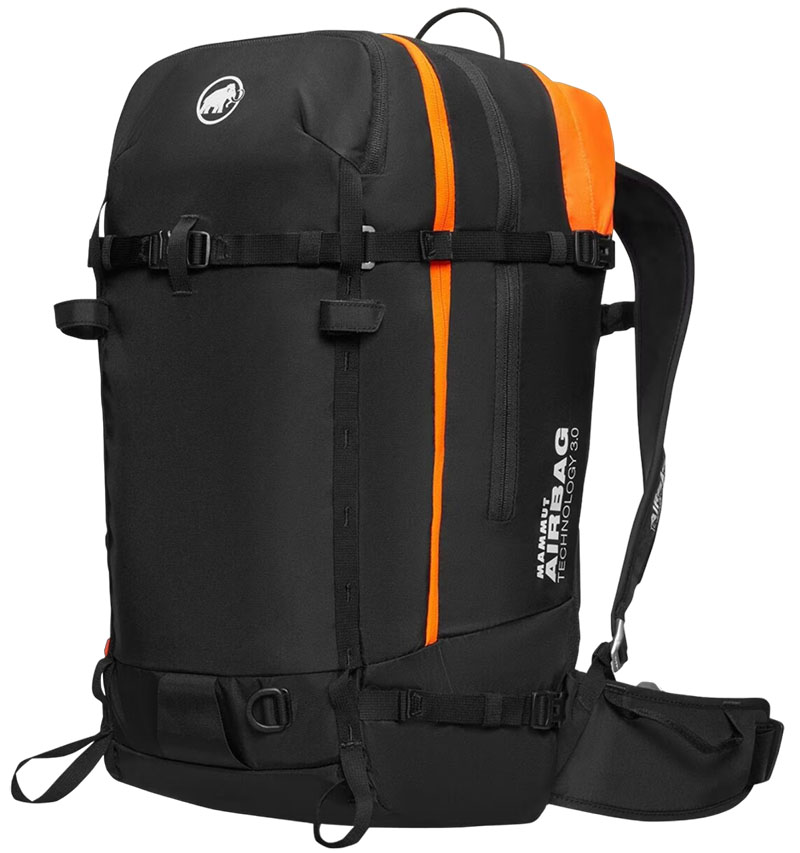 Category: Airbag
Category: Airbag
Capacities: 35, 45L
Weight: 5 lb. 12.6 oz.
What we like: An airbag pack for significantly less than the BD JetForce Pro above.
What we don’t: Electric systems are a bit more user-friendly.
Electric fan airbags (like the Black Diamond JetForce Pro above) are the wave of the future, but you can save a lot of money with a canister-powered design. Mammut’s Pro 35 Removable Airbag 3.0 is an undisputed leader in this category for its mix of performance, capacity, and features. The 35-liter size is versatile for anything from day tours to extended trips, a full rear zip makes it easy to access gear, and the internal aluminum frame does a great job distributing the weight of a heavy load. But the main event here is the Removable Airbag System 3.0, a ubiquitous unit that is compatible with various packs from brands like Jones, Dakine, Highmark, and more. It all adds up to a great two-in-one deal: You get a high-quality ski pack and a versatile airbag unit that can easily be removed or used elsewhere, all for $1,005 ($780 for the airbag and pack, plus $225 for the air canister).
But as we touched on above, there are a fair number of downsides to canister designs. Namely, canisters are difficult to travel with, require refilling after each use, and can only be deployed once per fill. But many will appreciate the simple mechanical system that doesn’t use complex wiring or technology, and at 5 pounds 12.6 ounces (this spec includes the 1.5-lb. canister), the Pro 35 is noticeably lighter than the JetForce Pro above (and about $500 cheaper). All in all, if you’re set on a canister airbag, Mammut’s time-tested Removable Airbag collection is a great place to land, and you won’t be disappointed with the Pro’s organization and comfort.
See the Mammut Pro 35 Removable Airbag 3.0
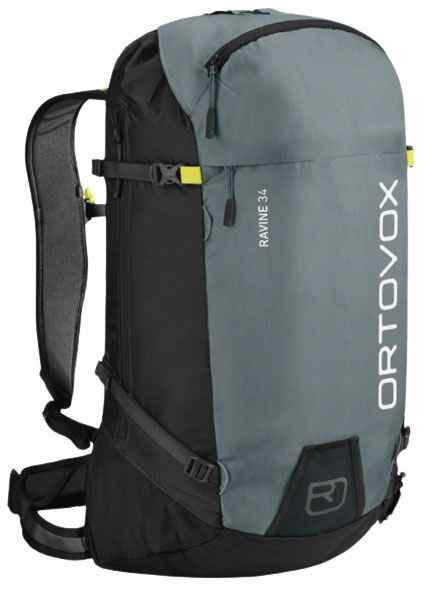 Category: Ski mountaineering
Category: Ski mountaineering
Capacities: 28, 34L
Weight: 2 lb. 2.6 oz.
What we like: Serious ski mountaineers will appreciate the lightweight design and on-the-go storage features.
What we don’t: Overkill for casual day tours.
Ortovox might not be a big name this side of the Atlantic, but the German-based company is widely known in Europe for their innovative and high-quality gear and apparel. The Ravine is one of their newest ski packs and among their most technically savvy, built for serious, uphill-oriented skiers. The 34-liter version is noticeably lightweight—on par with the BD Cirque 45 above—but still offers an impressive feature set that prioritizes on-the-go accessibility, including the ability to don skis and access crampons without removing the pack. And like most of the ski mountaineering designs here, you also get a dedicated avy tool compartment and external attachment for a rope, helmet, and ice axe.
That said, not every backcountry skier needs all these features. For example, casual day trippers will find the dedicated crampon pocket and on-the-go ski storage to be fairly unnecessary, and the lightweight design misses out on convenient touring features like backpanel access to the main compartment. What’s more, at $240 (or $220 for the 28L version), you’re certainly paying for the added tech. In terms of capacity, the 34-liter pack is a bit too small for most overnight trips—unless you’re touring between huts in Canada or Europe—but ideal for ski mountaineering missions that require all the tools in the toolbox. All told, serious skiers will find a lot to like about Ortovox’s Ravine 34, which is available in large and small (the 32 S) frame sizes.
See the Ortovox Ravine 34 See the Ortovox Ravine 32 S
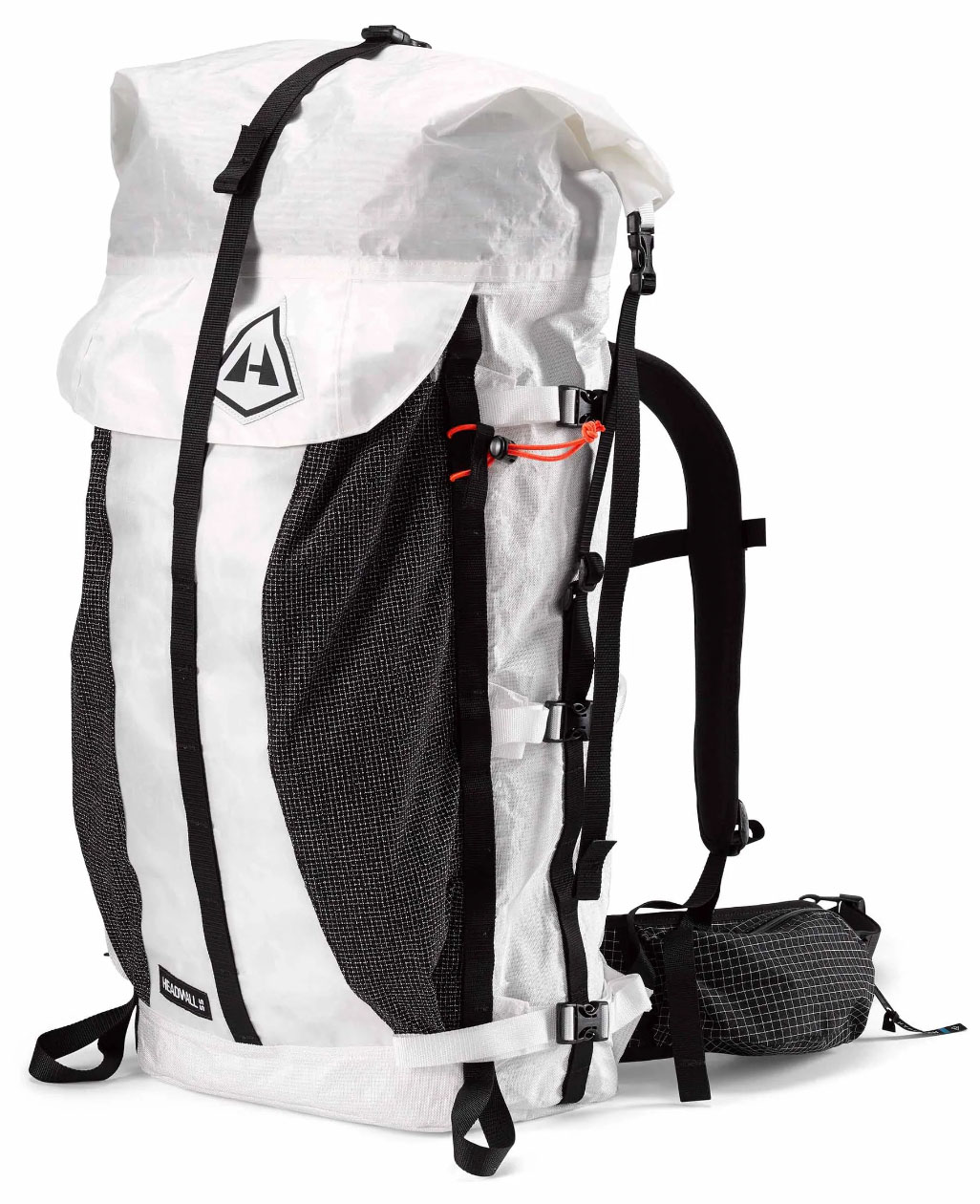 Category: Ski mountaineering
Category: Ski mountaineering
Capacity: 55L
Weight: 2 lb. 9.6 oz.
What we like: Dyneema construction is highly durable, waterproof, and lightweight.
What we don’t: Expensive and not great for day touring.
If you’re looking for a durable, waterproof ultralight backpack for ski mountaineering missions, it’s hard to top Hyperlite’s Headwall 55. The Headwall is made with Dyneema, which is known for its class-leading strength-to-weight ratio in addition to being highly water-resistant. What’s more, Hyperlite designed the pack with a roll-top closure (for even greater waterproofing) and no external zippers, meaning there are very few breakable parts that can malfunction in the field. And in addition to the cavernous main compartment, the Headwall features a generously sized internal zip pocket, stretchy front pouch for avy gear (and more), and hipbelt pockets that are large enough to accommodate a large smartphone and snacks.
We put a lot of use into the Headwall throughout last season, and overall we really like the design for overnight or gear-heavy ski missions. That said, it’s not the ideal pack for day touring—there’s a lot of fabric at the top you’ll need to roll down to compress a less-than-full load, and it’s not the most convenient pack for transition-heavy yo-yo laps (unlike the BD Cirque above and Patagonia Descensionist below, the Headwall does not feature a side zipper). And while we’ve found it fairly comfortable to carry, it’s very tall and skinny when loaded down, and the lack of load lifters at the top of the shoulder straps means the pack can feel a little wobbly. Minor gripes aside, the Headwall is a cut above the rest in terms of technical prowess. If you’re willing to fork over the $449, it’s a wonderful option for serious ski mountaineers.
See the Hyperlite Mountain Gear Headwall 55
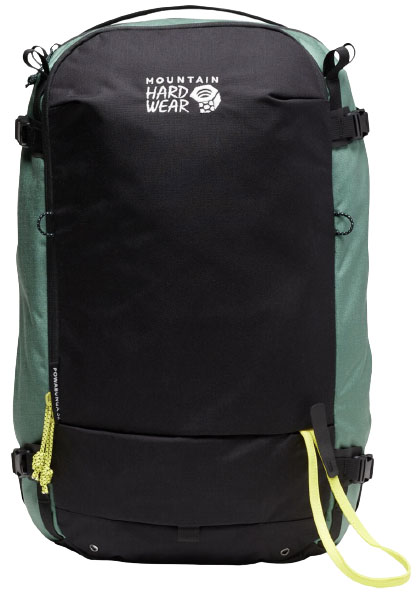 Category: Day touring
Category: Day touring
Capacity: 32L
Weight: 3 lb. 3.4 oz.
What we like: Durable, comfortable, and unique organization via expandable side pockets.
What we don’t: Pricey; disappointing access to the main compartment.
Mountain Hardwear returned to the backcountry ski world with three new pack designs: The ski mountaineering Snoskiwoski 40, the resort and sidecountry-specific Gnarwhal 25, and the Powabunga 32 here. Designed to offer convenience and comfort for both resort and backcountry riding, the Powabunga competes with designs like the Patagonia SnowDrifter and Black Diamond Dawn Patrol above. Like those models, the Mountain Hardwear is primed for day use with a dedicated avy tool compartment and handy backpanel access to the main compartment. It also has a supportive suspension system–a steel frame helps distribute the load, while the pivoting hipbelt moves with your body–and durable construction with hardwearing 500-denier Cordura nylon throughout. Finally, those who appreciate generous organization will love the zippered side pockets, which expand to accommodate bulkier items like skins, gloves, or a thermos.
That said, we do have a few gripes with the Powabunga. The first is price: $200 is a lot to pay for a relatively unproven design (you can pick up BD’s Dawn Patrol for the same price or save $21 with the SnowDrifter), which is an immediate demerit for the new pack. Second, front entry to the main compartment is limited—you can access it via a small zipper inside the fleece-lined goggle pocket, but we strongly prefer packs with large top-access zippers. Finally, the Powabunga lacks an ice axe slot and can’t accommodate a snowboard (it can carry a splitboard, but only when separated). These complaints aside, we applaud Mountain Hardwear for creating such a supportive and durable pack, which is enough to earn it a spot on our list for the 2024 season.
See the Mountain Hardwear Powabunga 32
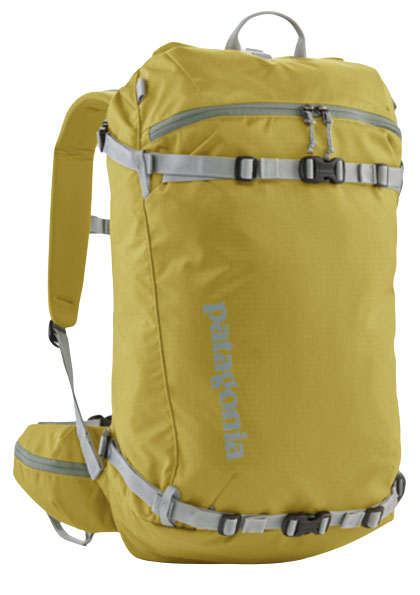 Category: Ski mountaineering/day touring
Category: Ski mountaineering/day touring
Capacity: 40L
Weight: 2 lb. 13 oz.
What we like: Durable, fully featured, and versatile ski/snowboard carry.
What we don’t: No backpanel access to the main compartment and heavier than the Cirque above.
Like the Black Diamond Cirque above, the Patagonia Descensionist is built for long days in the mountains when fast and light is the name of the game. The pack boasts a breathable harness and backpanel that keep you cool on the skin track, and the innovative strap system allows you to carry skis or a snowboard in several configurations. Additionally, the roll-top closure streamlines weight and accommodates varying loads (Patagonia also includes a helmet-carry attachment), and the full side zip and hipbelt pockets keep gear easily accessible. Finally, the Descensionist comes fully equipped to handle all your technical tools: It includes rope straps, internal and external ice tool attachments, and a dedicated safety tool pocket that keeps your avy gear organized and close at hand.
Before you opt for such a minimalist design, keep in mind that the Descensionist gives up the convenience of full backpanel access, which many skiers and riders really appreciate for transitions. The Patagonia does offer easier access to the snow tools pocket than BD’s Cirque—and includes the aforementioned side-zip entry to the main compartment—but it’s no replacement for a large backpanel opening. And among trimmed-down designs, the Descensionist loses out to the Cirque in weight by more than half a pound (while offering 5 fewer liters of capacity), although it does get the edge in durability and has more ski and snowboard carry options. Added up, the Cirque gets our overall vote due to its more convenient design and time-tested performance, but the Descensionist is a worthy alternative for weight-conscious skiers and riders... Read in-depth review
See the Patagonia Descensionist 40L
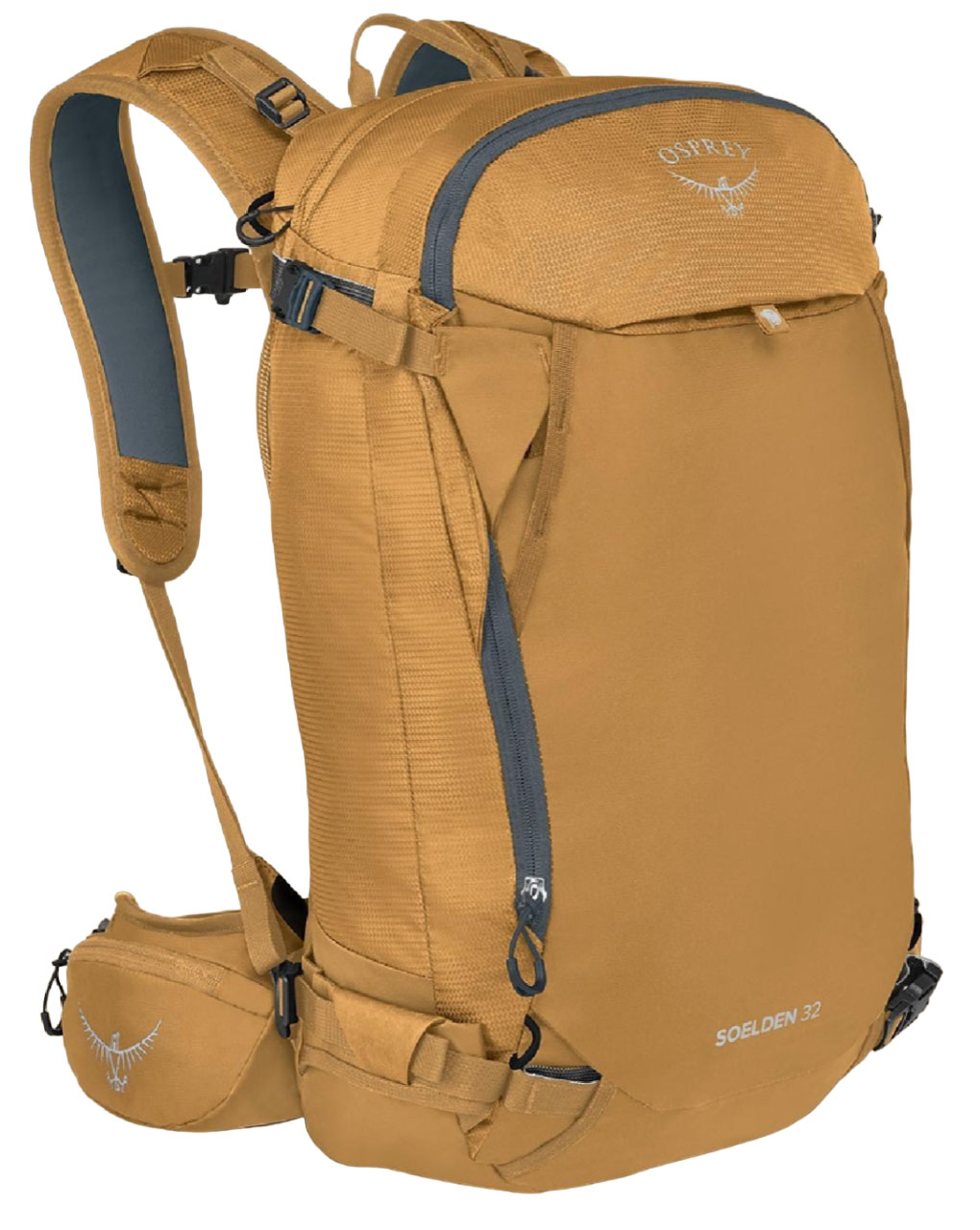 Category: Day touring
Category: Day touring
Capacities: 22, 32, 42L
Weight: 2 lb. 8 oz.
What we like: Great fit, comfortable suspension, and tons of organization.
What we don’t: Lacks the structure of more padded designs.
For day tours, sidecountry exploration, and dawn patrol laps, the Osprey Soelden 32 is a well-designed pack that quickly and easily transitions between the skin track and the downhill. It checks all the right boxes for all-around use, with a durable yet lightweight build, functional organization, and both ski and snowboard carry. Lay it on its front to access your gear via the full-zip backpanel, or prop the bag on its base to grab your shovel or probe from the dedicated avy-tool pocket. And the true cherry on top is fit: Osprey consistently nails the comfort equation, and unlike most ski packs the Osprey comes in both men’s (Soelden) and women’s (Sopris) models.
However, we do have some gripes about the Soelden’s organization. Notably, you have to undo the compression straps to access the avy tool compartment. It also feels noticeably unstructured compared to more padded designs like the Black Diamond Dawn Patrol and Patagonia SnowDrifter above, which makes transitions a little less smooth. Most skiers and snowboarders will want to stick with the aforementioned packs for day touring, but those in need of a more fine-tuned fit will appreciate what Osprey has to offer. The Soelden also comes in 22- and 42-liter versions, along with a “Pro” airbag pack ($1,400) that features the modern Alpride E2 airbag system.
See the Osprey Soelden 32 See the Osprey Sopris 30
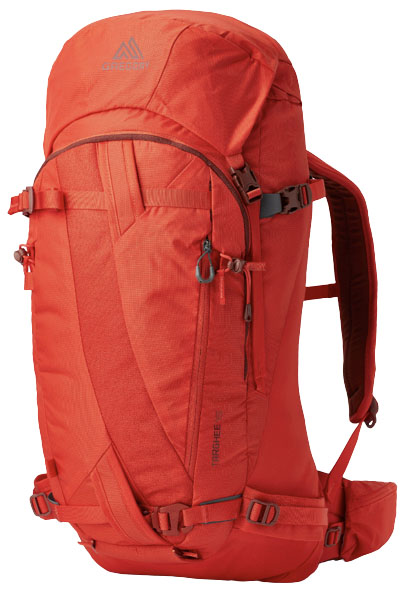 Category: Ski mountaineering
Category: Ski mountaineering
Capacities: 26, 32, 45L
Weight: 3 lb. 10.6 oz.
What we like: Fully featured and comfortable.
What we don’t: Does not ski especially well; straps and pockets add significant weight.
We’ve lauded many of the packs above for shaving weight and bulk, but in reality, not all skiers are laser-focused on traveling fast and light. If you’re willing to shoulder a bit more weight, the Gregory Targhee is one of the most comfortable and fully featured options on this list. The Targhee sports a whopping six external pockets, as well as an insulated hydration sleeve, helmet-carry system, and convenient backpanel access to the main compartment. The 45-liter capacity with removable lid also gives you a bit more room for customization, making it a versatile choice for those looking for a quiver-of-one pack. Further, the Targhee’s beefy build and thick fabrics are confidence-inspiring and made to last.
As we’ve come to expect from Gregory, the Targhee carries loads quite comfortably thanks to an alloy frame, adjustable suspension, and compression-molded backpanel. In fact, it’s our in-house photographer’s pack of choice when hauling heavy cameras and lenses into the backcountry. Size-wise, 45 liters is great for technical days or short overnights, but it can feel a bit unwieldy when skiing downhill (for day tours, check out the two smaller models, which are also available in women’s versions). And forsaking just a few liters of capacity, we’ve found that packs like the Patagonia Descensionist and Deuter Freerider Pro offer a closer and less ungainly fit. But for the ultimate in comfort and convenience when you need to carry more than an average day’s worth of supplies, the Gregory Targhee 45 should be on your short list. And for a pared-down design with Gregory's FastTrack carry system (which allows you to stow and remove your skis without taking off your pack), check out the Targhee FastTrack 45.
See the Gregory Targhee 45
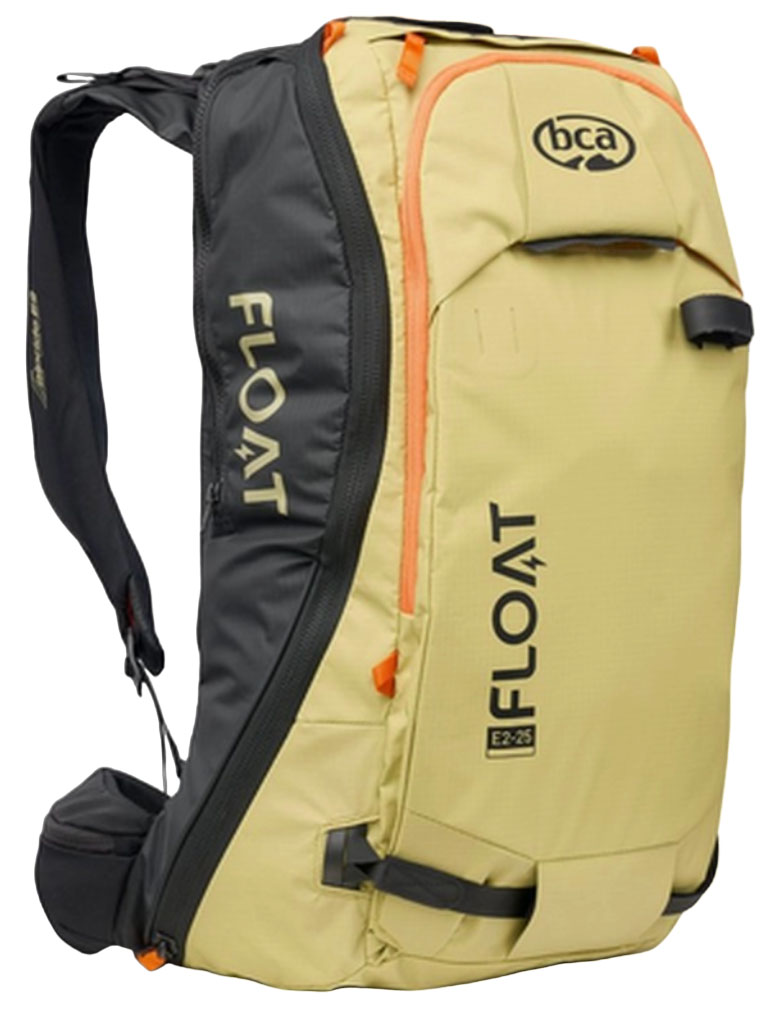 Category: Airbag
Category: Airbag
Capacities: 25, 35, 45L
Weight: 6 lb. 2.5 oz.
What we like: A durable workhorse backpack with modern Alpride E2 airbag tech.
What we don’t: Supercapacitor-powered airbags are pricier than canister models.
Above, we feature airbag packs that are powered by battery and air canister (the BD JetForce Pro and Mammut Pro, respectively), but there’s a third airbag technology that’s made a lot of waves in recent years: the supercapacitor. We won’t go too deep into the nitty gritty of supercapacitors, but the long and short is that they’re quick to charge, relatively small and lightweight, and don’t pose any travel issues. And the Alpride E2—featured in the Backcountry Access Float E2-25 here—is the best iteration yet. It’s significantly more streamlined than the outgoing E1 (40% smaller and 4.9-oz. lighter), features an LCD screen to display battery levels, and offers speedy charging via USB-C. For winter 2024, we’re seeing this technology used in packs from brands like Scott, Deuter, and Osprey—but the Float is one of the most refined designs of the bunch.
In true BCA style, the Float pack is a reliable workhorse, with robust 420-denier waterproof coated nylon, burly zippers, and aluminum hardware. The storage is top-notch, including a fleece-lined goggle pocket, hipbelt pockets, and a massive side stash to access your water bottle on the go, and you also get sleek hydration reservoir and radio integration, which we don’t always see on airbag designs. On the outside, the modular strap system works well for attaching everything from poles and ice tools to skis or a snowboard (and as a cool bonus, the included straps can be swapped out for ski straps). And in terms of options, the Float comes in two torso sizes and three capacities, and the Alpride E2 system is fully removable. The end result is a really functional, hardwearing, and versatile airbag pack that can also play double-duty for low-hazard days.
See the BCA Float E2-25
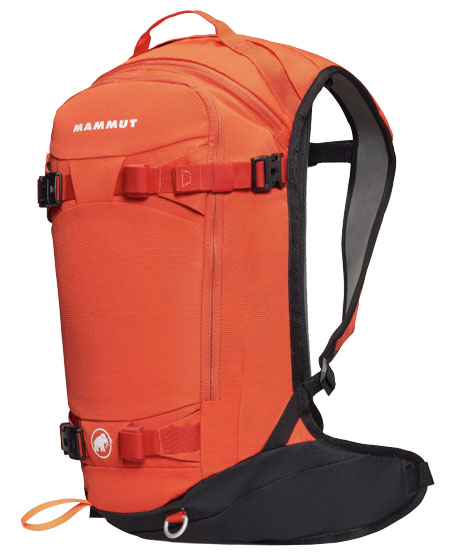 Category: Resort/day touring
Category: Resort/day touring
Capacities: 18, 25, 30, 35L
Weight: 2 lb. 3.3 oz.
What we like: A just-right size for sidecountry-bound resort skiers.
What we don’t: Not as performance-oriented as the Ortovox Free Rider below.
Year after year, Mammut churns out some of the ski industry’s best packs, including a complete lineup of airbag designs and their standard Nirvana series here. Perfectly sized for resort laps or days when you let the sno-cat or helicopter do the work, the Nirvana 18 packs a serious punch into a diminuitive package. Similar to feature-rich designs like the Dawn Patrol and SnowDrifter above, the Nirvana offers access to the main compartment via a full-zip backpanel, and a dedicated front pocket allows you to grab safety tools quickly and conveniently. You also get a variety of external attachment points for ice tools and trekking poles, along with compatibility with most hydration systems. Like many packs of this size, the Mammut does not accommodate skis in an A-frame configuration, but you can utilize the large buckles on the front panel for strapping skis diagonally or a board vertically.
With its fairly limited capacity, the Nirvana 18 falls short as a dedicated day touring pack, but it’s a nice option for resort skiers that dip into the sidecountry from time to time. In the end, choosing a capacity is all about finding that just-right balance between having sufficient space and keeping your pack streamlined enough for an unencumbered descent. Compared to the Ortovox Free Rider below, the Nirvana accomplishes this at a much lower cost (you save $75), although serious freeriders will appreciate the added protection and back-hugging fit that the Free Rider offers. Mammut also offers the pack in 25, 30, and 35-liter capacities, the latter of which comes in dedicated men’s and women’s versions.
See the Mammut Nirvana 18
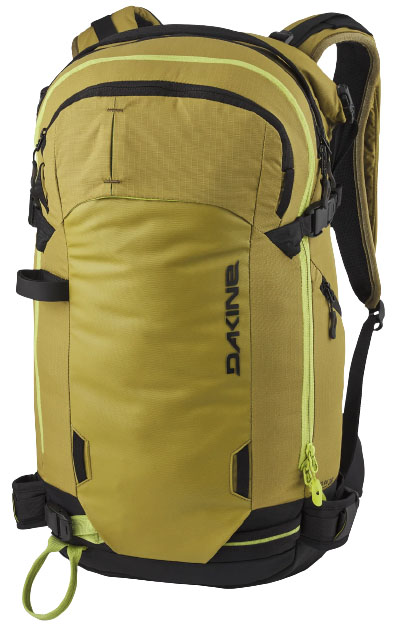 Category: Day touring
Category: Day touring
Capacities: 18, 26, 36L
Weight: 4 lb. 1.6 oz.
What we like: Quality day-touring pack with the option to add an airbag system.
What we don’t: Heavy and fairly expensive.
In contrast to their relatively simple and budget-oriented Heli Pro above, Dakine’s Poacher is among the more feature-rich ski packs on the market. To start, you get a range of carry options, including A-frame, diagonal, and a vertical snowboard set-up. Plus, organization is excellent with a zippered backpanel access, helmet attachment, and dedicated pockets for avy tools and a ski goggle. But what really sets the Poacher R.A.S. apart is its compatibility with Mammut’s Removable Airbag System 3.0 (seen in the Mammut Pro 35 above). Adding the airbag and canister tacks on another $725 to the bottom line, but at $995 all-in, you get excellent versatility for day touring or hut adventures.
What are the downsides of the Poacher R.A.S.? The pack by itself is pretty spendy at $270, especially when you consider it’s not markedly better than the $70-cheaper Dawn Patrol 32 above (other than its airbag compatibility). In addition, the Dakine is rather heavy for its capacity at over 4 pounds, although that does include a mix of burly 500- and 840-denier nylon on the pack body, the extra roll top closure for the airbag, and the intuitive storage layout mentioned above. Finally, if you like the design but don’t plan to get the airbag, Dakine makes a non-R.A.S. Poacher 32 that ditches the airbag pocket and saves you $55 (with a slight drop in capacity).
See the Dakine Poacher R.A.S. 36L
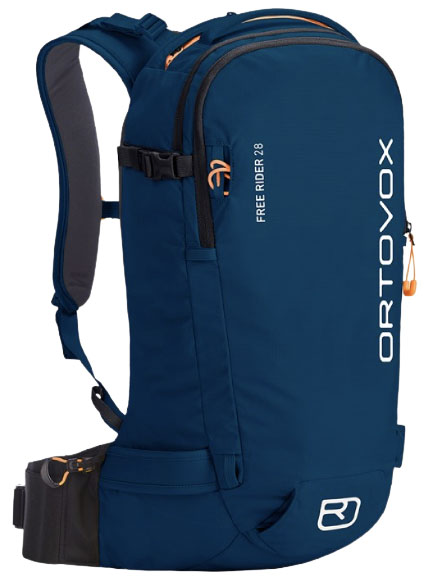 Category: Day touring
Category: Day touring
Capacities: 22, 28L
Weight: 2 lb. 8.6 oz.
What we like: Built-in back protection and body-hugging fit.
What we don’t: Pricey for the fairly limited capacity.
If you’re a skier or snowboarder that lives for the descent, the Ortovox Free Rider 28L has your name on it—literally. This pack differs from many of the standard models here with the option for an add-on foam protector that conforms to the contours of your back and hardens to absorb impacts in the event of a crash. To keep it all in place, a wide, elasticized hip strap extends high off the backpanel, hugging your body and ensuring you get protection where you need it (many critical organs can be impacted through the back). Finally, compression straps near the top and on the hipbelt cinch the load close to your back, allowing it to ride as an extension of your body. All told, for committed freeriders that want a streamlined pack for maximum agility on the descent, the Ortovox is a high-performance option.
Despite the Free Rider’s minimalist build, organization is high with both backpanel and top access to the main compartment, along with a dedicated safety tools pocket. But while the pack’s 22- and 28-liter sizes can accommodate the essentials for cat- or heli-accessed terrain, you’ll likely want a bit more capacity on human-powered days. Further, you’re paying a bit of a premium for the purpose-built design—for reference, the Free Rider is $21 more than the Patagonia SnowDrifter 30L above, which is by far the more versatile choice. On the flip side, the Ortovox’s added protection and closer fit will be well worth it for hard chargers. And if you’re looking for a descent-oriented pack but don’t anticipate needing the back protector, Ortovox’s simplified Cross Rider 22L ($140) can save you some hard-earned cash.
See the Ortovox Free Rider 28L See the Ortovox Free Rider 26L S
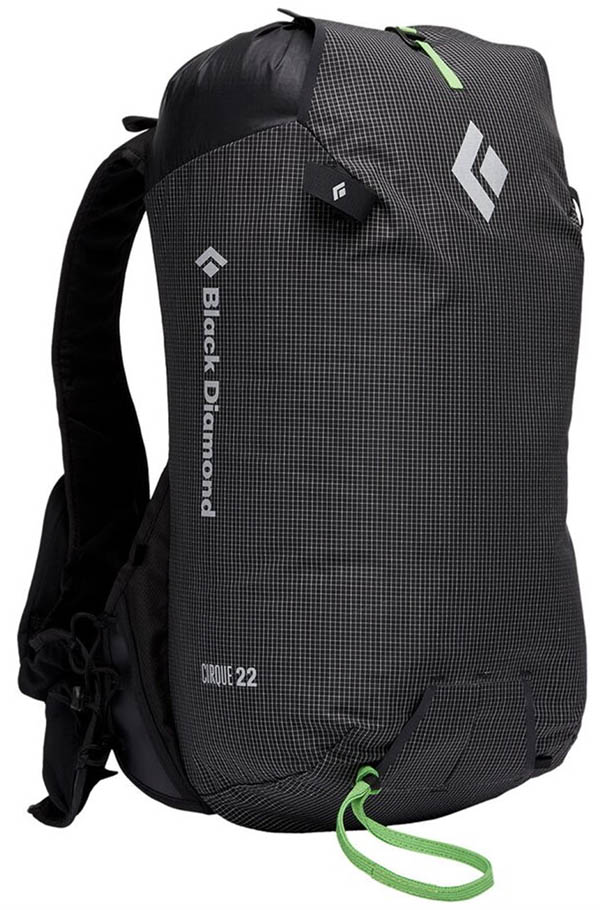 Category: Day touring/ski mountaineering
Category: Day touring/ski mountaineering
Capacity: 22L
Weight: 1 lb. 8 oz.
What we like: Purpose-built for quick transitions and on-the-go access.
What we don’t: A very niche feature set and not very supportive.
Moving fast and light has never been more in vogue, and backcountry skiers are hot on the trend with everything from leg-burning dawn patrols and Everest-in-a-week challenges to big in-a-day spring missions. Black Diamond’s Cirque 22 meets this style head-on, combining the on-the-go ethos of a running vest with all the storage and attachment points you need for a day of skiing. The big selling point here is accessibility: with a quick-stow diagonal ski carry, side crampon/skin stash, and front pockets for water and snacks, you’ll almost never need to remove the vest throughout the day. Tack on a dedicated avy-tool compartment, removable helmet carry, and two ice tool slots, and the Cirque Vest is the complete package for fast efforts in all sorts of terrain, whether you’re skimo racing, tackling your own PR, or just enjoy moving efficiently through the mountains.
But with only 22 liters of capacity and a vest-style strap system (read: no hipbelt), the Cirque Vest is fairly limited to quick hits when you’re not carrying much in the way of layers or extra supplies. What’s more, it’s bound to feel overburdened with anything more than a fairly light ski setup (it pairs well with BD’s narrow Cirque skis), and the diagonal carry system does not accommodate a snowboard. Further, while the Cirque Vest’s on-the-go access will be a game-changer for some, most casual users will want the convenience of standard features like a full-zip backpanel or fleece-lined goggle pocket instead. Like any purpose-built design the Cirque has its fair share of tradeoffs, but skiers with a need for speed will be hard-pressed to find a better-suited pack. For a more affordable design that forgoes the Cirque’s vest-like shoulder straps, check out the Ortovox Trace 20 and 25 ($110 and $130, respectively).
See the Black Diamond Cirque 22 Vest
| Ski Backpack | Price | Category | Capacities | Weight | Access |
|---|---|---|---|---|---|
| Black Diamond Dawn Patrol 32 | $200 | Day touring | 15, 25, 32L | 2 lb. 9 oz. | Backpanel, top |
| Dakine Heli Pro 20L | $100 | Resort/day touring | 20, 24L | 1 lb. 14 oz. | Top |
| Osprey Glade 12 | $130 | Resort | 5, 12L | 2 lb. 0.4 oz. | Top |
| Black Diamond JetForce Pro 25 | $1,500 | Airbag | 10, 25, 35L | 6 lb. 8 oz. | Top |
| Black Diamond Cirque 45 | $220 | Ski mountaineering | 30, 35, 45L | 2 lb. 4 oz. | Top, side |
| Patagonia SnowDrifter 30L | $179 | Day touring | 20, 30L | 2 lb. 10 oz. | Backpanel, top |
| Gregory Verte 12 | $110 | Resort | 12, 18L | 1 lb. 6.7 oz. | Top |
| Deuter Freerider Pro 34+ | $190 | Mountaineering/touring | 34+10L | 2 lb. 13 oz. | Backpanel, top |
| Mammut Pro 35 Removable Airbag | $1,005 | Airbag | 35, 45L | 5 lb. 13 oz. | Top |
| Ortovox Ravine 34 | $240 | Ski mountaineering | 28, 34L | 2 lb. 2.6 oz. | Top, side |
| Hyperlite Headwall 55 | $449 | Ski mountaineering | 55L | 2 lb. 9.6 oz. | Top |
| Mountain Hardwear Powabunga 32 | $200 | Day touring | 32L | 3 lb. 3.4 oz. | Backpanel, top |
| Patagonia Descensionist 40L | $219 | Mountaineering/touring | 40L | 2 lb. 13 oz. | Top, side |
| Osprey Soelden 32 | $180 | Day touring | 22, 32, 42L | 2 lb. 8 oz. | Backpanel, top |
| Gregory Targhee 45 | $220 | Ski mountaineering | 26, 32, 45L | 3 lb. 11 oz. | Backpanel, top |
| Backcountry Access Float E2-25 | $1,250 | Airbag | 25, 35L | 6 lb. 2.5 oz. | Side |
| Mammut Nirvana 18 | $125 | Day touring | 18, 25, 30, 35L | 2 lb. 3.3 oz. | Backpanel |
| Dakine Poacher R.A.S. 36L | $270 | Day touring | 18, 26, 36L | 4 lb. 1.6 oz. | Backpanel, top |
| Ortovox Free Rider 28L | $200 | Day touring | 22, 28L | 2 lb. 8.6 oz. | Backpanel, top |
| Black Diamond Cirque 22 Vest | $180 | Touring/mountaineering | 22L | 1 lb. 8 oz. | Top |
*Editor's note: prices and weights include batteries or canisters where applicable.
Skiing can take a variety of forms, from lift-served turns to quick dawn patrol laps before work, traveling the week-long Haute Route in the Alps, or seeking out powder stashes deep in the backcountry. Given the variety and the notable differences in pack designs for each use, we’ve broken our picks into four separate categories: resort, day touring, ski mountaineering, and airbag backpacks.
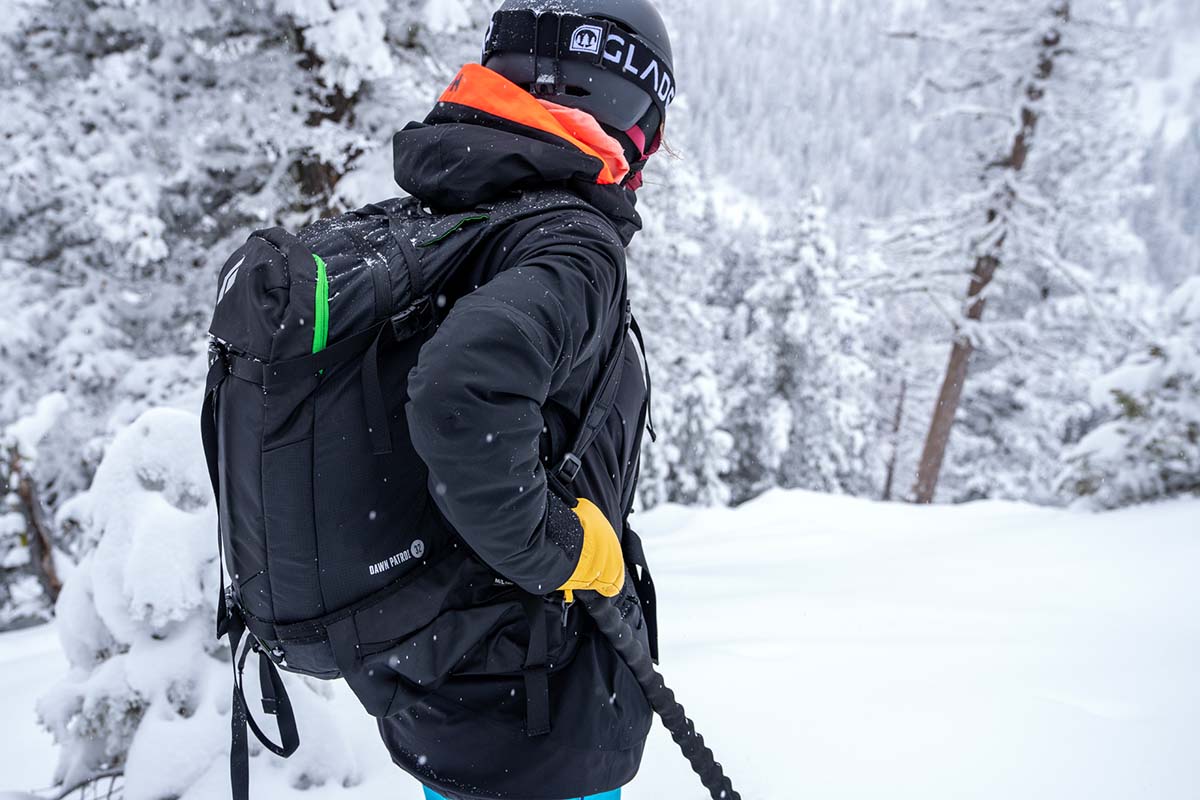
Resort
A resort pack is the ideal choice for in-bounds riding, sidecountry terrain, and even sno-cat or heli-accessed skiing. The main distinguishing factor here is capacity—packs in this category are around 5 to 22 liters in size, which is perfect for carrying your water and snacks, an extra layer, and avy tools (if needed). For lift-accessed terrain, you’ll also want to look for a clean exterior with minimal straps to avoid snagging the chairlift when loading/unloading. Most of these packs feature an insulated sleeve for storing a water reservoir, which is great for staying hydrated without removing your pack. Some of our favorite designs in this category include the Osprey Glade 12 and Mammut Nirvana 18, and it’s also worth checking out smaller-capacity versions of many of the other packs above.
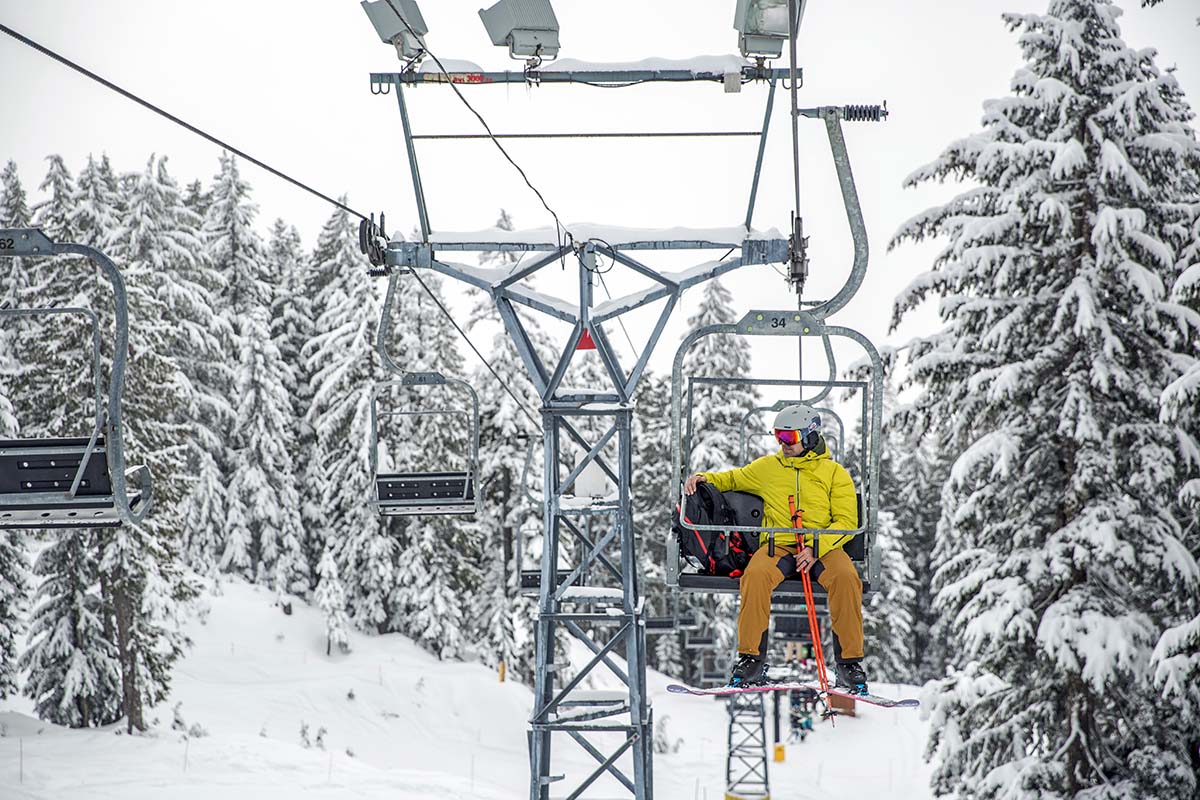
Day Touring
Packs in our day touring category are a great fit for close-to-home backcountry tours. When you’re earning your turns, you’ll be transitioning a lot from touring to skiing, so a good day-touring pack will prioritize organization with features like full backpanel access to the main compartment, external accessory pockets, and a dedicated snow goggle pocket. They also place a high priority on comfort (over the weight-savings of ski mountaineering designs), with robust backpanels and nicely padded hipbelt and shoulder straps. Most backcountry skiers and riders will appreciate a pack in the 25- to 35-liter range, which is a just-right capacity for accommodating your food and water, extra layers, avy tools, helmet (on the uphill), and skins (but not quite enough for overnight gear or technical equipment like a rope and harness).
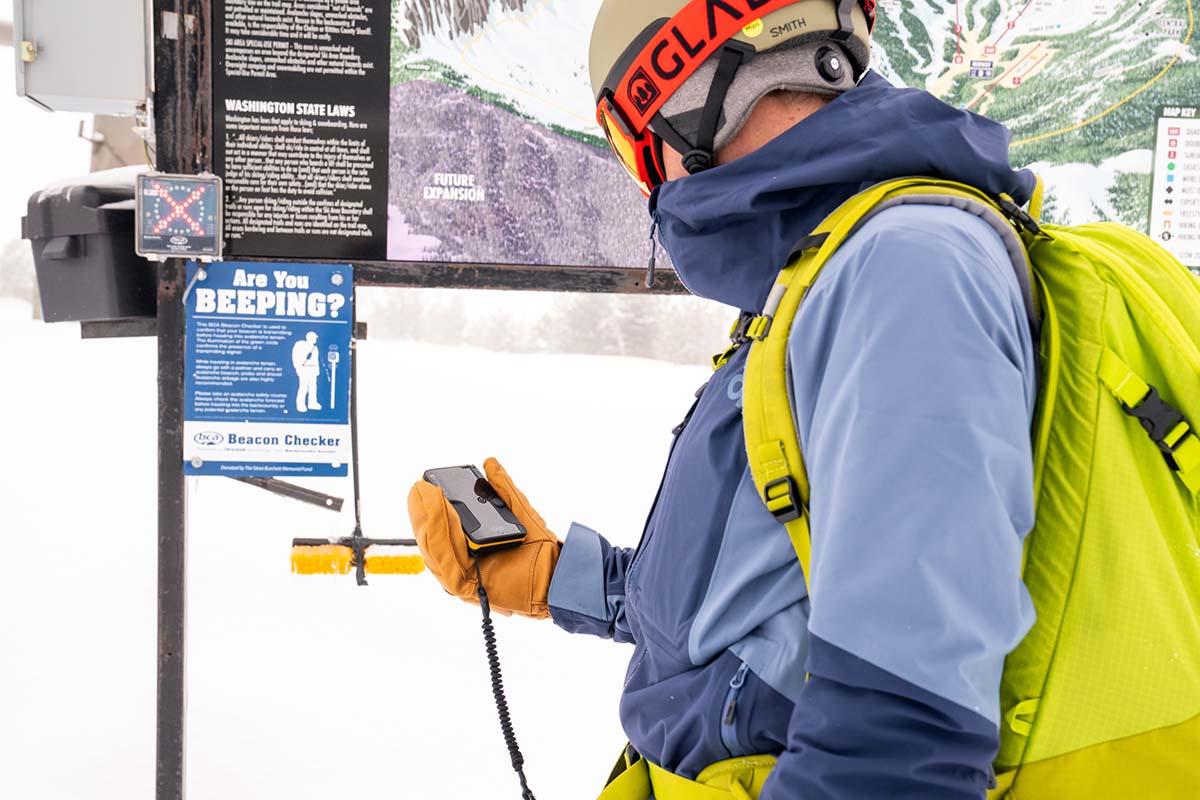
Ski Mountaineering
Ski mountaineering—not to be confused with skimo racing—is a discipline of skiing that involves venturing into more technical, mountainous terrain. Ski mountaineers might encounter glaciers, ice, steep snow, and even dry trail along their route, and missions can often be multiple days long. To account for the added gear and technicality, ski mountaineering packs offer a bump in performance in more streamlined packages to shave crucial weight. Look for dedicated ice tool and pole attachments, a helmet-carry system, external straps for ski or snowboard carry, lighter-weight fabrics, and supportive suspension systems. Ski mountaineering packs will often range from 35-45 liters to accommodate technical or overnight gear. Our favorite packs in this category are the Black Diamond Cirque, Ortovox Ravine 34, and Patagonia Descensionist 40L, which do a great job balancing weight-savings and comfort.
.jpg)
Airbag
One of the dangers of an avalanche is that it can pull you deep under the snow, making rescue a physical and time-consuming process. To help increase chances of survival, airbag packs include a bag that inflates to about 150 liters, allowing skiers to stay close to the surface rather than being sucked under (this is governed by the process of granular segregation, which states that larger objects will stay on top of a mixture while smaller objects will sink to the bottom). Additionally, airbags provide a barrier around the head and neck to guard against obstacles like rocks and trees. By nature, these packs are heavier, more expensive, and have limited capacities, but they're still common in heli-skiing, cat-skiing, lift-served backcountry skiing, or day-touring applications. Additionally, some designs allow you to remove the airbag mechanism completely, which gives you the versatility of traveling with or without the extra load.
.jpg)
There currently are two types of mechanisms used to inflate airbags: compressed air and electric fans. When a canister is triggered, it shoots air (or gas) into the bag, inflating it in about three seconds. Powered by batteries or supercapacitors, fans also are activated with a pull cord and take around the same time to inflate. Where do the two differ? First and foremost, while canister airbags are generally lighter and less expensive than electric systems, they can only be deployed once. Fans, on the other hand, can often be used multiple times on a single charge (like Black Diamond's JetForce Pro) and are easily recharged. This allows skiers to practice without the hassle and cost of expending canisters (if you don’t live near a refill location, you’ll have to mail the cartridge in for replacement). Finally, fan-powered airbags can be taken on airplanes with relative ease, while canister models are trickier and require you to empty the air beforehand (compressed gas canisters cannot be taken on a plane at all). For a closer look at the market, see our article on the best avalanche airbag packs.
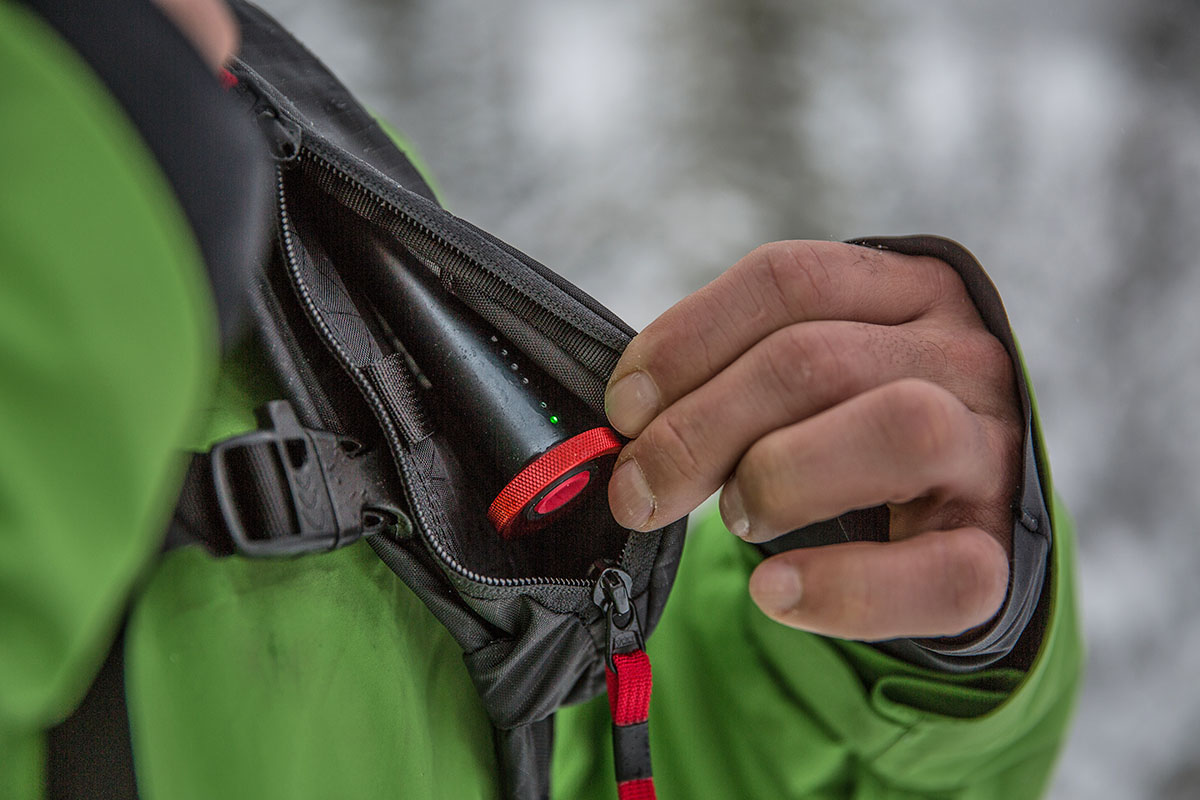
Ski backpacks come in a range of sizes, from compact 20-liter packs for sidecountry or heli-accessed skiing to large 40- to 50-liter packs for overnight trips and technical ski mountaineering. Resort-goers leaving the rescue gear behind can likely get away with an even smaller pack like the Osprey Glade 12. But in our experience, the sweet spot for most skiers is in the 30- to 40-liter range, which is where the majority of the picks above fall. These are perfect skiers who enjoy long days at the resort or short backcountry outings, and provide ample space and organization for avalanche gear, extra layers, skins, food, and water. We also feature a few packs in slightly larger sizes for overnight trips or exceptionally frigid days when you want to carry along your bulky puffy jacket and thermos of tea. However, keep in mind that the larger your pack’s capacity (and the more you load inside), the more cumbersome it will feel on the downhill.
.jpg)
Ski backpacks range from lightweight 2-pound models to heavy airbag-equipped bags like the Black Diamond JetForce Pro, which clocks in at 6.5 pounds. For those focused on moving quickly on the skin track or who don’t want to be weighed down on the descent, a lightweight pack—along with lightweight gear both inside and underfoot—should be a top priority. If you want added carrying comfort or an airbag system, expect a big bump in weight. Finally, you should keep in mind that a pack’s weight is generally correlated with its level of supportiveness: the lighter the pack, the less padding and suspension it offers.
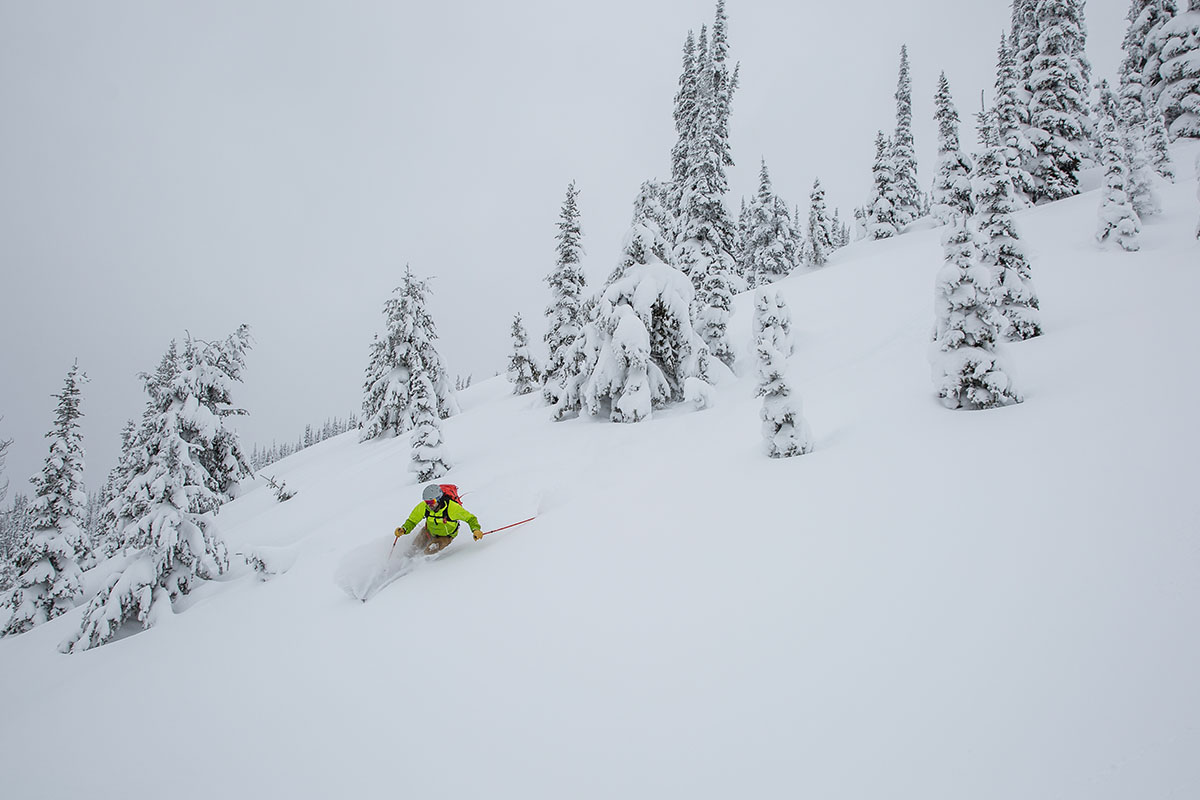
In general, ski backpacks are a durable breed, built to hold up to seasons of use (and abuse). How your pack will fare over time is a combination of a few things: the fabric thickness, the makeup of other materials (including buckles, foam, and zippers), and the quality of construction. Fabric thickness is expressed in terms of denier, with higher numbers denoting burlier fabrics. The packs on our list range from about 100-denier (for the Black Diamond Cirque 22 Vest) to 840-denier (for the Dakine Poacher R.A.S.)—if you anticipate getting a lot of use out of your pack, it’s worth opting for a design with thicker fabric, although do keep in mind this comes with a weight penalty.
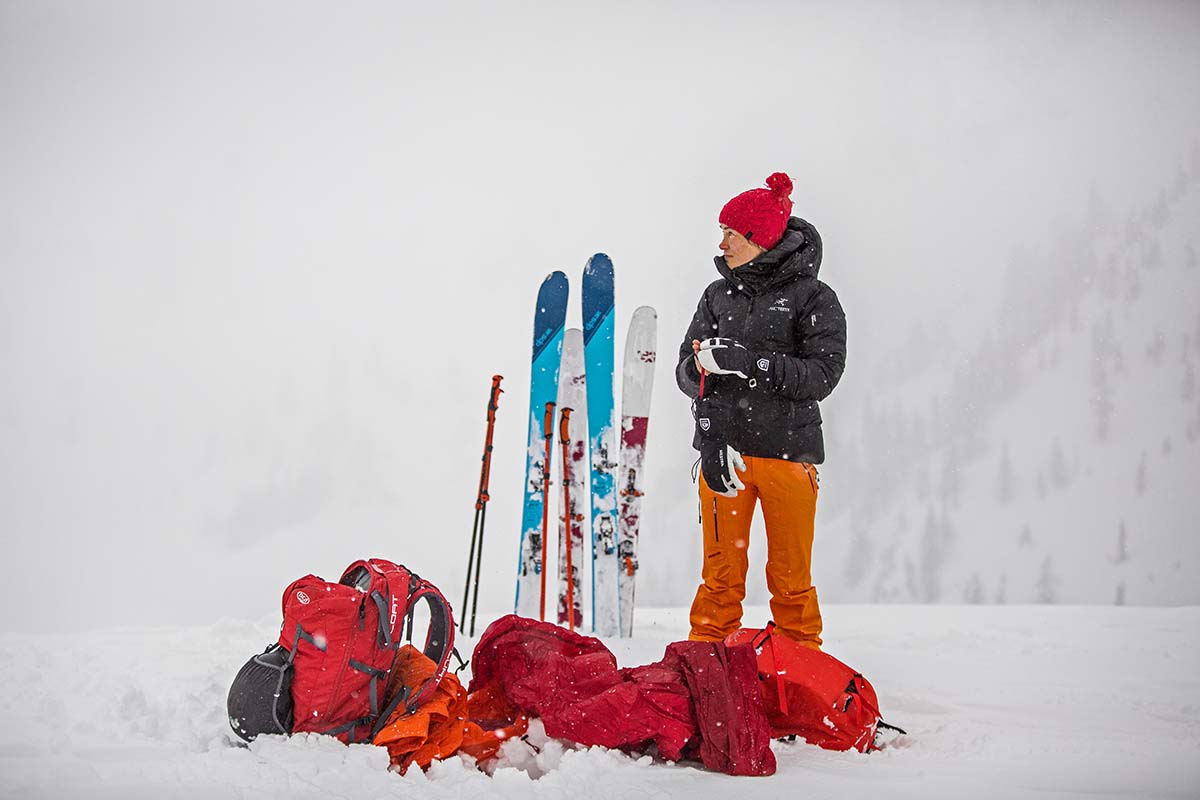
In terms of other materials, look for packs with thick zippers, wide webbing, and metal (rather than plastic) components. For example, the Black Diamond Dawn Patrol features a metal hipbelt buckle, which is a bit more finicky than a plastic buckle, but will last throughout the lifespan of the pack. It’s also worth noting that metal and plastic frames stay stiff over time, while foam has a tendency to degrade and lose its structure. Finally, brand and price point can be a helpful guide in finding a long-lasting pack: Companies like Patagonia, Ortovox, Osprey, and Deuter are known for quality, while a budget offering like the Dakine Heli Pro ($100) will only last a season of consistent use.
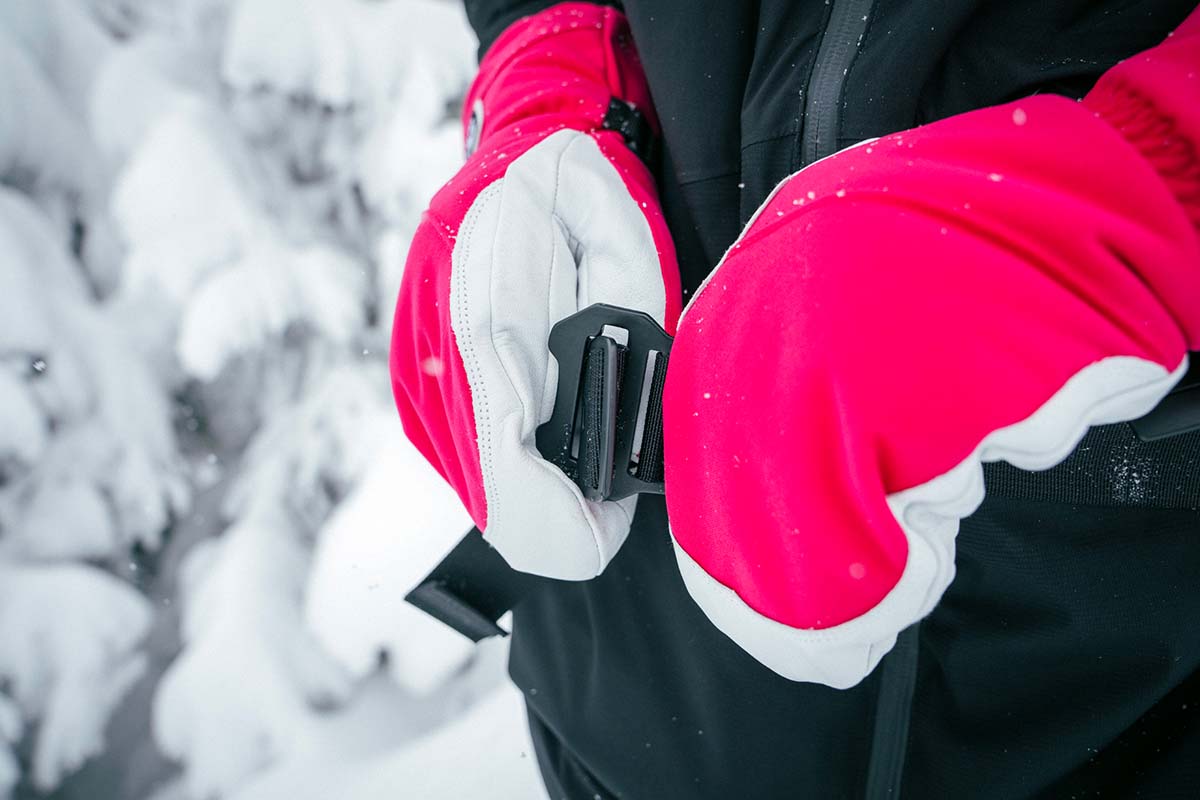
Many factors contribute to a pack’s overall comfort, including the shape and size, beefiness of the suspension, and the amount of adjustment the pack offers. For those who prioritize freedom of movement on the downhill, a pack that is streamlined and sits close to the back (look for smaller capacity, minimalist suspension, and compression straps) will perform better than a pack with a bulky suspension system that separates the load from the body. On the other hand, when weighed down with 40+ liters of gear on the skin track, you’ll be thankful to have a robust backpanel (packs like the Gregory Targhee 45 even incorporate an internal wire frame, which offers a lot of extra support for hauling heavy loads), shoulder straps, hipbelt, and features like load lifters that allow you to dial in fit.
.jpg)
In the end, it’s important to identify your priorities and understand that there will be tradeoffs with any pack you choose. A good place to start: Are you more focused on the uphill or downhill? For instance, the Gregory Targhee is one of the most comfortable packs on our list, but some will find that its heavy-duty suspension is too restrictive for aggressive skiing. On the other hand, many of the lightweight options above (like the Black Diamond Cirque 45) sacrifice support to shave weight, which can make skinning and bootpacking rather arduous. And interestingly, most manufacturers offer larger-capacity packs with the same suspension as their smaller counterparts, so don’t necessarily expect to find increased support as you size up.
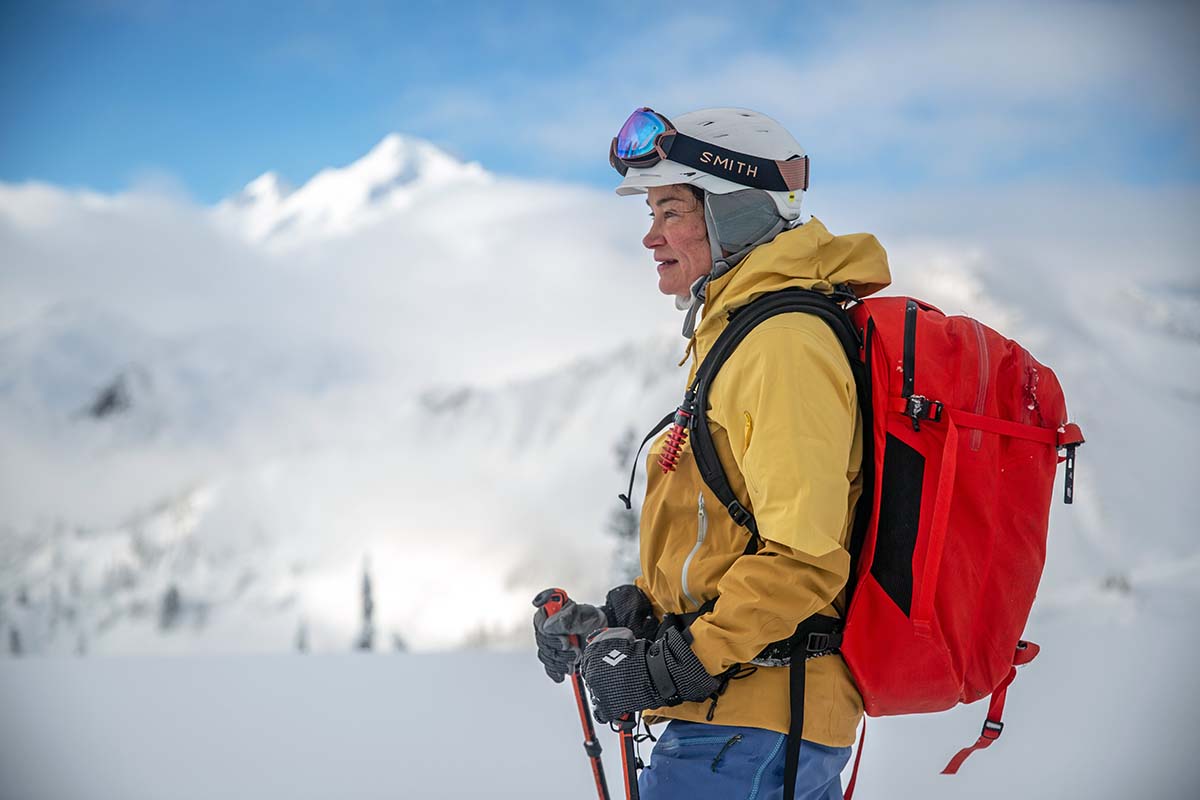
One way that ski packs stand out from standard hiking daypacks or climbing packs is in their access to the main compartment. Most ski packs feature multiple access points—usually a combination of a top drawstring or zipper paired with a side zip or a back/front panel zip. Because skiing tends to be very transition-heavy and you’re in an out of your pack a great deal, multiple access points allow you to get at gear in every nook and cranny without needing to take anything out.
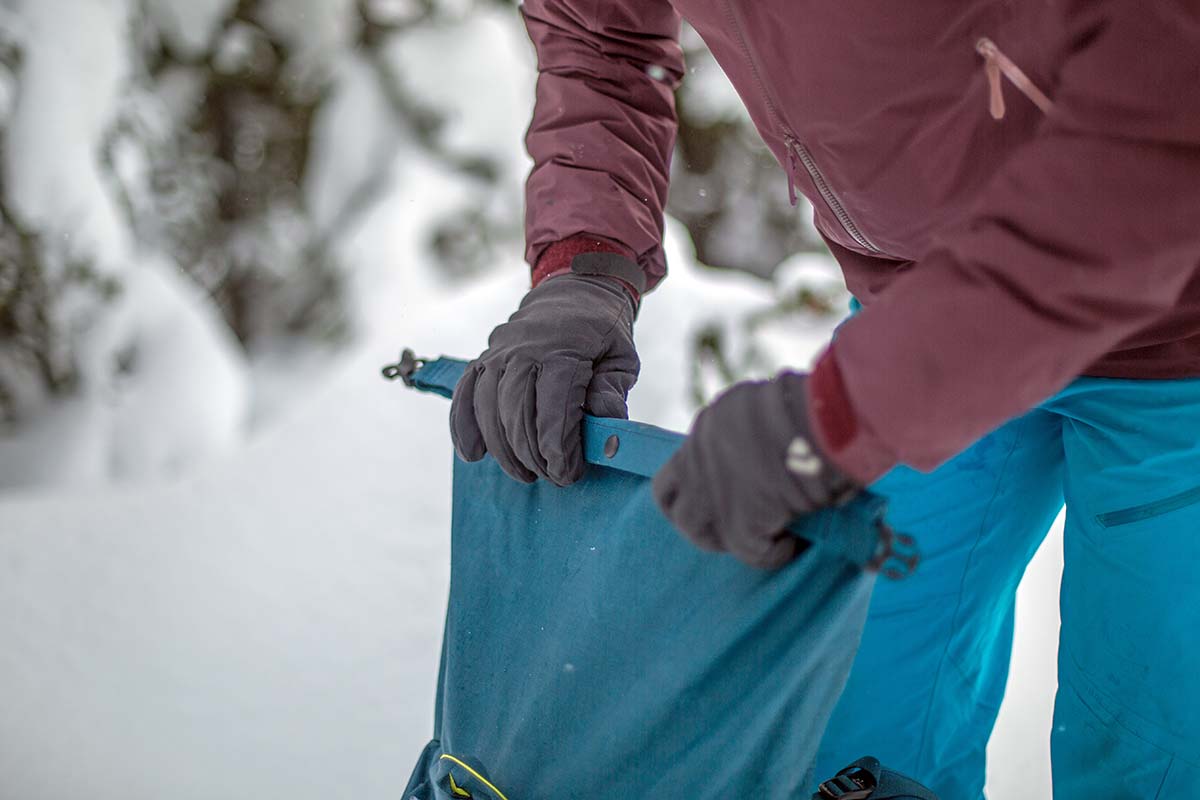
When deciding on a pack, think about how often you’ll need to access gear throughout the day and in what sort of environments. For those who want to open their pack on the chairlift, a top zip is great for getting at snacks, water, or a goggle wipe. Alternatively, when skiing laps in our local backcountry bowl, we prefer a pack with a U-shaped backpanel zip (like that of the Black Diamond Dawn Patrol 32 or Patagonia SnowDrifter) that allows us to see all our gear and use our pack as an ad hoc staging area during transitions. Ski mountaineers who have longer approaches and descents (and are thus transitioning less) can get away with a more streamlined opening (the Patagonia Descensionist 40L features a roll top and side zips, for example). Finally, speed-focused skiers and endurance athletes will benefit from the on-the-go access of a vest-style design like the Black Diamond Cirque 22.
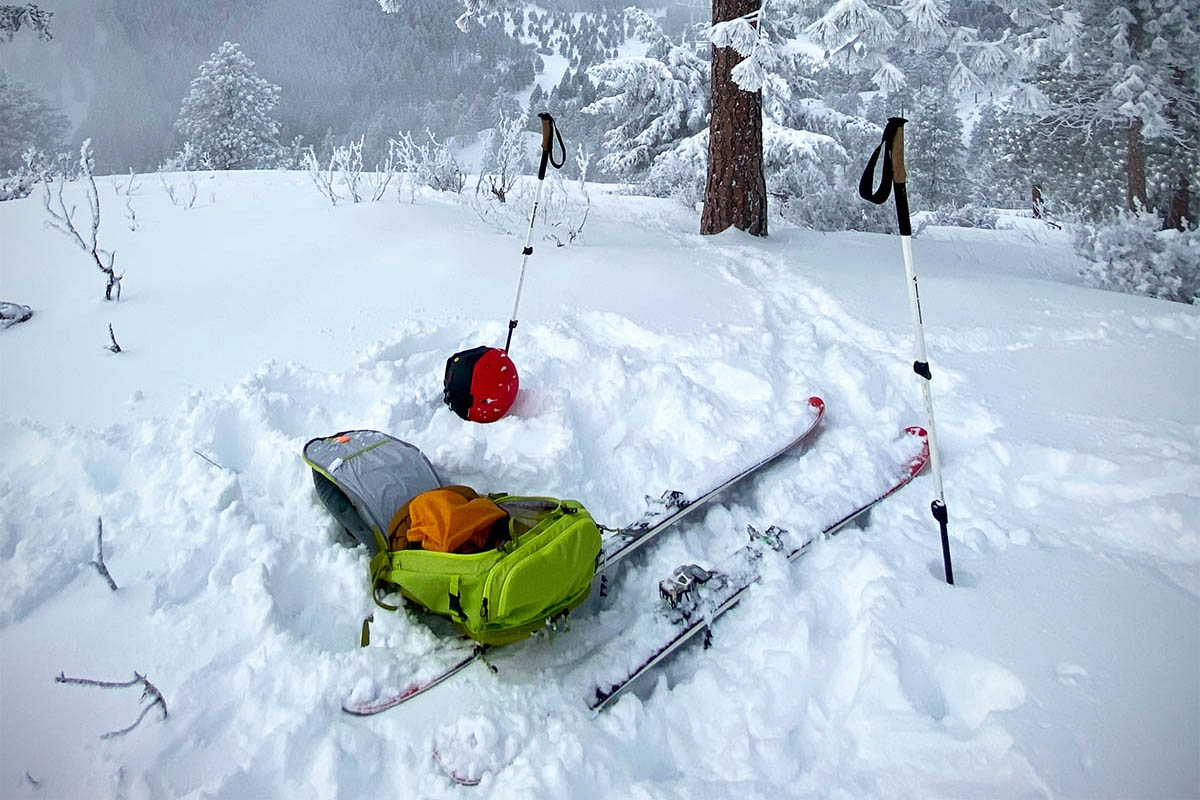
Avalanche Gear Compartment
Many new skiers will use a hydration pack, climbing pack, or hiking daypack for in-bounds days or ski touring. However, we highly recommend that those venturing into the backcountry purchase a ski-specific pack for one main reason: safety. The vast majority of ski backpacks have a dedicated avalanche gear compartment, allowing for quick access to your shovel and probe in the event of a slide. Some, like the Patagonia SnowDrifter, feature a dedicated zip pocket, while others, like the Black Diamond Cirque 45, have a pouch in the main compartment. No matter the design, the goal is to make your rescue equipment easily accessible. When purchasing a pack, make sure the compartment is large enough to fit your gear and that it’s easy to access regardless of what you might strap onto the outside.
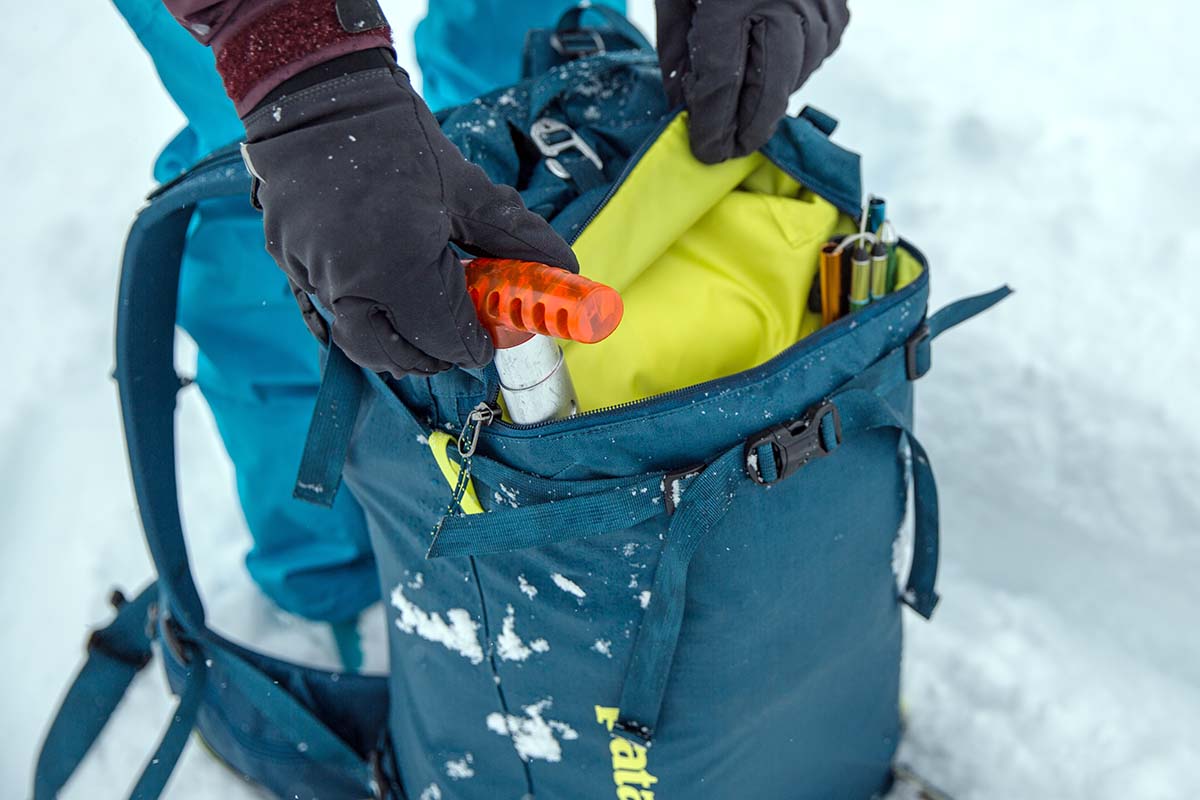
Accessory Pockets
Most ski backpacks feature at least one pocket in addition to the main compartment and avalanche gear compartment. We find this extra pocket extremely useful for smaller items such as goggles, sunglasses, lip balm, and snacks. Often, this pocket is also fleece-lined to protect your ski goggles, which is a nice touch. Sometimes, it’s located on the inside rather than the outside of a pack, which streamlines the exterior but is less convenient to access.
.jpg)
Compression Straps
Your pack’s load will likely change throughout a day of skiing as you swap layers and transition. To account for this, most ski packs are designed with compression straps along the sides that allow you to snug down a partially full load so that it rides close to your back and doesn’t feel unwieldy. These straps are also especially helpful for streamlining larger-capacity bags. For example, the Deuter Freerider Pro 34+ is a good option for overnight trips, but thanks to its roll-top and compression straps, it can be tightened down to serve as a comfortable day-touring bag.
All that said, packs with compression straps or other external straps generally aren’t ideal for resort skiers, as they’re more likely to get caught on the chairlift. Instead, look for packs with clean exteriors and minimal outer features. Further, you should always exercise caution while getting off a lift with a pack. The best method is to sling it over one shoulder rather than both, and make sure you’ve undone both the waist belt and sternum strap before unloading.
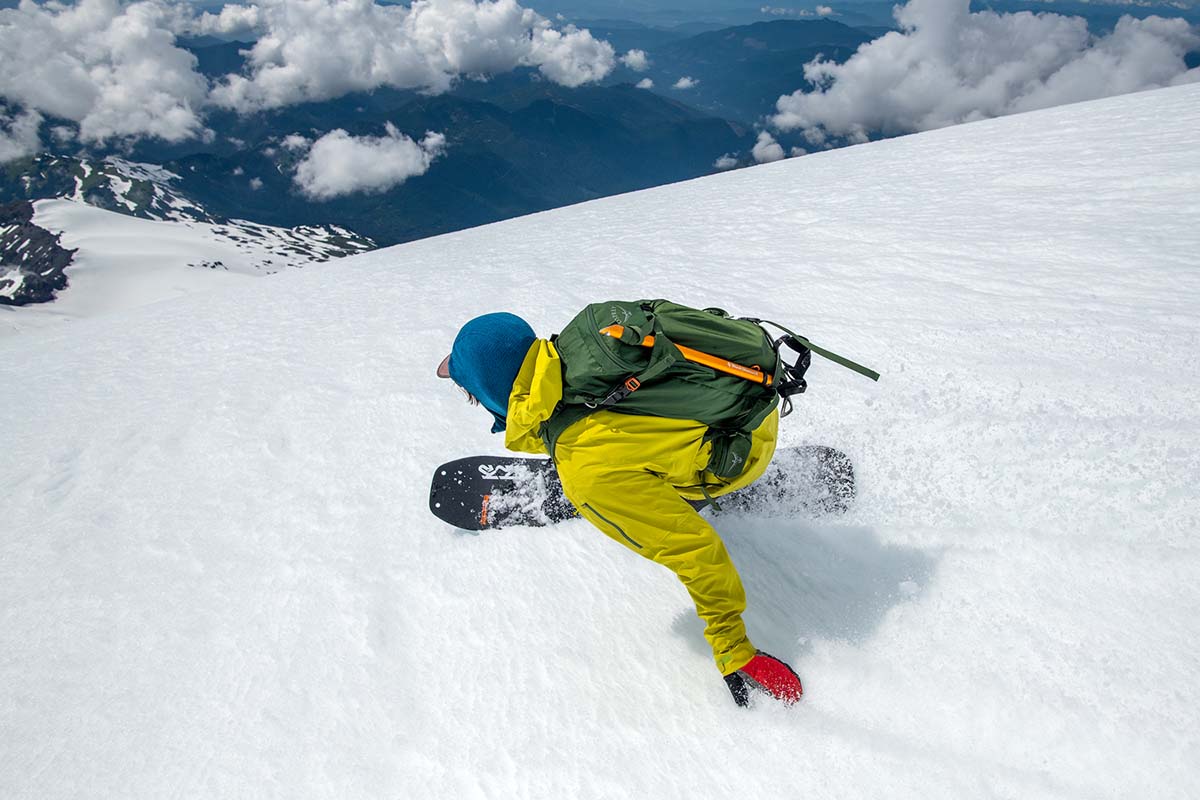
External Attachment Points
Many ski packs—and especially those tailored to ski mountaineering—are made with various external attachment points, designed specifically for convenient storage of ice tools, poles, crampons, rope, and a ski helmet. Before making a purchase, it’s important to consider whether or not you really need these features—if you don’t, they might feel unnecessary and burdensome. And it’s worth noting that standard packs generally feature some variety of compression straps or ski-carry straps, which can be used to carry gear externally in a pinch. That said, ski mountaineers will appreciate the convenience of dedicated slots and systems for their ice tools, helmets, and ropes, like those found on the Gregory Targhee 45.
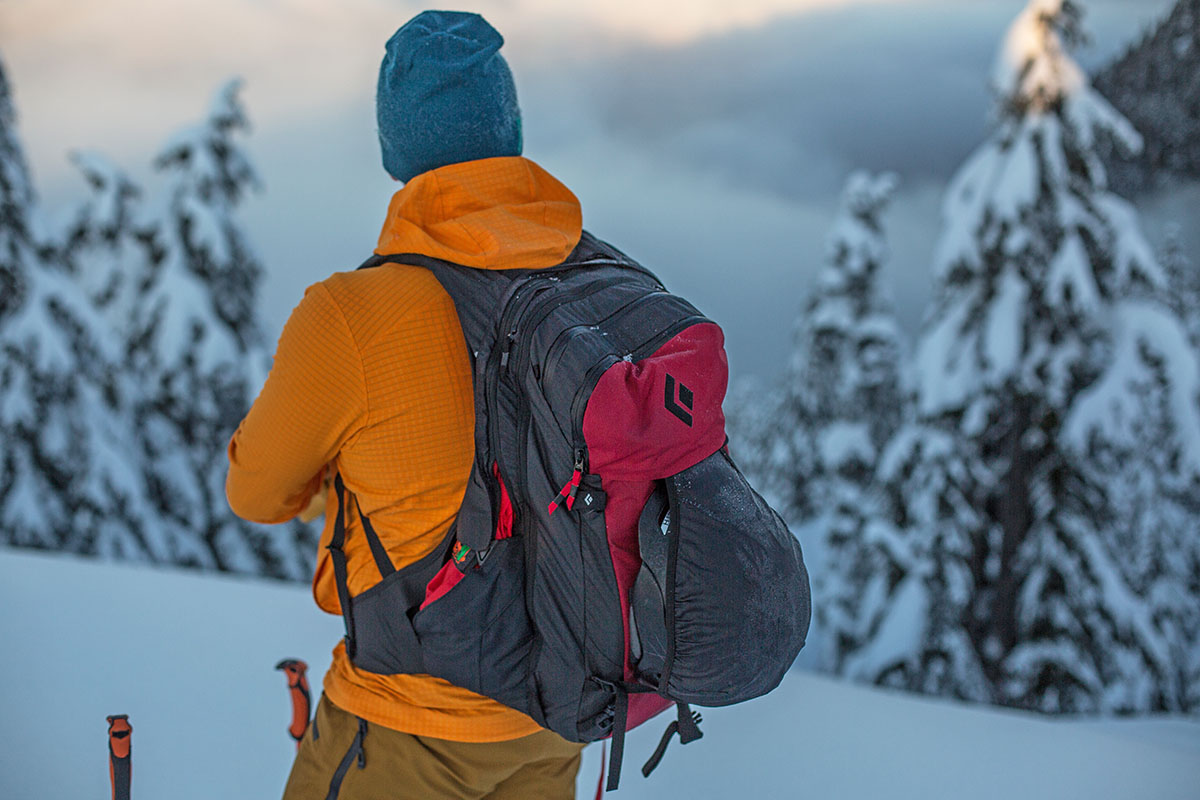
All of the packs in this article are designed with external straps for attaching skis (or often a snowboard) to the outside. These straps are incredibly useful in the event that you need to hike with your skis on your back, which is common in ski mountaineering and accessing hike-to terrain at resorts. In terms of design, some packs allow you to attach lightweight skis in both diagonal and A-frame configurations, while others limit you to one setup or the other (many airbag-equipped packs, for example, do not support A-frame carry). Further, it’s not rare to find a pack that is is unable to haul a snowboard (the Black Diamond Cirque, for example).
.jpg)
The backpacks listed here are either unisex or men’s-specific models, but many manufacturers make ski backpacks in a women’s version as well (when applicable, the women’s model will be linked directly below the pack's write-up). Women’s packs can differ in both shape (namely of the suspension system) and capacity, and often vary in colorway as well. For example, Osprey's Soelden 32 is also available in a women’s model called the Osprey Sopris 30. The Sopris comes in different color tones, a slightly smaller capacity, and with a hip belt and shoulder straps more contoured to fit a women’s body. Many backpacks on our list are only available in unisex models, but come in a variety of sizes (the Patagonia SnowDrifter is offered in S/M and L/XL). We find that unisex backpacks work for most females relatively well, but for the closest fit, we recommend that women look at women’s-specific packs.
Back to Our Top Ski Backpack Picks Back to Our Ski Backpack Comparison Table